Communication Efficiency and Non-Independent and Identically Distributed Data Challenge in Federated Learning: A Systematic Mapping Study
Abstract
1. Introduction
- Providing in-depth knowledge about the techniques that have been proposed to overcome the non-IID data challenge in FL.
- Offering a deep understanding of the techniques that have been proposed to provide efficient communication in federated learning.
- Identifying the widely used learning models and datasets and associating the respective learning models with the utilized datasets.
- Highlighting promising research directions that can open up new opportunities for future studies.
2. Preliminaries and Related Work
2.1. Preliminaries
2.1.1. Federated Learning
- The central server decides which devices are participating in training the model at this round.
- The selected participating devices receive the global model from the central server.
- The devices train a local model using their dataset and the received global model.
- Each device uploads the trained local model to the central server for aggregation.
- The received local models are aggregated to create the new global model.
- The steps are repeated until the target performance is accomplished (the target can be specific accuracy) or the deadline is reached.
2.1.2. Federated Learning Application
2.1.3. Non-IID Data in Federated Learning
- Feature skew: Feature skew indicates that the features differ among devices; this can be described as the being different while is the same. The features can be non-overlapped between devices, partially overlapped, or fully overlapped. In non-overlapping feature skew, the different devices have different features; this case is similar to vertical federated learning; images with different angles are an example. While in partial overlapping feature skew, some features can be overlapped. Full overlapping feature skew is a case similar to horizontal federated learning; an example is the case of having two datasets for the same numbers (digits), one is written in a bold line while the other is written with a thin line [33,34,35].
- Label distribution skew: Label distribution skew indicates that the devices have different labels; this can be described as the being different while is the same. This skew can happen when the device tends to have local data with the same labels (for example, it can be caused by location variations between devices) or labels from some classes more than others. Label skew is defined in different ways in two studies. The study in [21] introduces the quantity label imbalance, and the study in [36] introduces the distribution label imbalance. Generally, the amount of data belonging to the same class is not equal and varies between devices.
- -
- Quantity label imbalance: This situation occurs when the devices have a predetermined number of labels they can own. For example, all devices have data from two class labels only. If we take device () and device (), the labels in device () can be from class (), while those in device () can be from class (). This kind of distribution was first introduced in Federated Average (FedAvg) experiments. In this case, the smaller the label quantity, the stronger the label imbalance [21,33].
- -
- Distribution label imbalance: In this skew, each device has a proportion of the samples from each label class that follows Dirichlet distribution . The portion of the data that belongs to a specific class is distributed on device () with a probability , where is the concentration parameter that determines the imbalance level; a higher value indicates a high imbalance partition [33,35,36].
- Same feature, different labels: The case of the same feature with different labels implies that the distribution of is different but is the same. In this case, the same features indicate different classes (labels) on different devices; the data label for the same feature can be on the first device and on the other device. This could depend on the user preference; for example, in the same weather condition, some people may refer to a rainy day as good weather, while other people refer to the same rainy weather as a bad day [33,34].
- Same label, different features: The case of the same label with different features implies that the distribution of is different but is the same. Different features on different devices could belong to the same class. For example, the first device has images of a school building on a sunny day, and the second device has images of a school building on a rainy day; both can belong to the same class (school buildings), but they have different features [34]. For example, the first device has images of a residential building, and the second device has images of a factory building; both belong to the same class (buildings) but have different features.
2.2. Related Work
3. Research Methodology
3.1. Research Questions
- RQ1: Which non-IID type has been mainly addressed when overcoming the non-IID data challenge in federated learning?
- RQ2: What are the techniques that are utilized to overcome the non-IID data challenge that federated learning faces?
- RQ3: What are the techniques that are utilized to provide communication efficiency (to reduce the communication overhead) in federated learning?
- RQ4: What are the learning models utilized in these studies to perform the learning process?
- RQ5: What are the datasets utilized in these studies to evaluate the proposed work?
3.2. Search Strategy
- Search terms: We first started our work by identifying the search term and constructing the search string; our search scope was in the federated learning area; we focused on solutions for overcoming the non-IID data problem and on solutions for providing communication efficiency in federated learning. For that, we used the terms shown in Table 1.
- Search string: The search string used in the search process within the digital library was created by identifying keywords from populations, interventions, and outcomes. The search terms were as follows: “Federated Learning” AND ((“non-IID data” OR “non IID data” OR “non-I.I.D data” OR “not independent and identically distributed data”) OR (“Communication-efficiency” OR “Communication-efficient” OR “Communication efficiency” OR “Communication efficient”)).
- Database: In this work, we used six popular digital databases to perform our search; the databases used are shown in Table 2. The search string was customized to suit each digital library search mechanism.
3.3. Study Inclusion Criteria
- Conference and journal publications.
- Publication published from 2016 until the end of 2022.
- Publications that include the search string in their title or abstract.
- Publication written in English language.
4. Results and Discussion
4.1. Publication Years and Source Types
4.2. Results for Non-IID Data Studies
4.3. Results for Communication-Efficient Studies
4.4. Results for Studies Providing Solutions for Both Challenges
4.5. Discussion
4.6. Threats to Validity
4.7. Future Research Directions
5. Conclusions
Author Contributions
Funding
Institutional Review Board Statement
Informed Consent Statement
Data Availability Statement
Conflicts of Interest
Appendix A. Additional Tables
| Non-IID Data Type | Studies Referenced |
|---|---|
| Quantity label imbalance | [48,50,51,54,55,57,58,59,60,65,66,67,70,71,72,75,77,78,81,82,84,87,88,89,90,91,92,93,94,98,99,100,104,105,106,107,108,109,110,111,112,113,114,115,117,119,121,122,123,124,125,126,128,129,130,131,134,138] |
| Quantity label imbalance | [214,217,218,221,222,223,224,225,226,227,228,230,231,232,233,235,237,238] |
| Distribution label imbalance | [48,49,54,62,71,72,74,75,76,78,80,86,87,92,94,96,97,99,100,102,103,112,115,116,118,122,136,137,215,224,234,236] |
| Feature skew | [50,56,67,74,76,77,88,93,99,109,111,113,114,115,135,237,238] |
| Quantity skew | [61,68,91,109,116,119,214,218,232] |
| Same features, different labels | [50,67,76,99,111,113,114,115,125,237] |
| Same labels, different features | [52,103] |
| Techniques | Studies Referenced |
|---|---|
| Aggregation | [50,61,68,74,75,76,91,99,102,105,107,110,114,118,130,131,133] |
| Cluster | [54,56,77,82,97,100,103,108,109,116,122,125,127,135,138] |
| Personalized | [52,65,83,87,88,96,111,113,120,125,129,139] |
| Adaptive Approach | [48,49,59,81,95,97,99,112,115,116] |
| Client Selection | [47,50,53,56,63,84,86,128] |
| Data Sharing | [57,58,68,78,79,89,90,121] |
| Regularization | [55,126,131,133,138] |
| Knowledge Distillation | [71,111,124,134] |
| Hierarchical | [56,85,117] |
| Hierarchical Clustering | [67,88,119] |
| Model | Dataset | Studies Referenced |
|---|---|---|
| CNN | Cifar-10 | [48,53,54,55,60,61,62,66,70,73,76,79,84,86,97,98,99,100,101,102,103,105,108,111,115,119,122,128] |
| MNIST | [48,54,59,60,61,66,67,70,72,75,82,84,86,93,97,98,100,104,105,108,114,119,122,128] | |
| FMNIST | [48,51,53,59,60,61,73,77,79,81,86,89,97,99,100,105,117,122,126] | |
| FEMNIST | [56,76,77,99,109,113,114,115] | |
| EMNIST | [72,93,95,104] | |
| Other | [50,62,73,80,81,88,90,93,98,102,112,114,134] | |
| ResNet | Cifar-10 | [71,74,78,91,107,118] |
| Cifar-100 | [52,69,71,76,83,136] | |
| Tiny ImageNet | [55,62] | |
| Other | [52,55,69,71,74,101,118] | |
| VGG | Cifar-10 | [69,72,74,75,106,113,114,117,124,130] |
| Cifar-100 | [72,106,113,114] | |
| SVHN | [69,74,124] | |
| Other | [69,124,136] | |
| LSTM | Shakespeare | [50,76,99,111,114,115,125] |
| Other | [51,95,111,123] | |
| MLP | MNIST | [57,69,77,98,102,108] |
| FEMNIST | [69,77,109] | |
| FMNIST | [77,129] | |
| Other | [77,108,123,129] | |
| LeNet | MNIST | [68,101,107,117] |
| Cifar-10 | [52,92,93,96] | |
| FMNIST | [107,117,130] | |
| Other | [92,96] | |
| MLR | Synthetic | [77,84,125] |
| MNIST | [59,77,84] | |
| FEMNIST | [77,111] | |
| FMNIST | [59] | |
| MobileNet | Cifar-10 | [106,107] |
| Cifar-100 | [106,136] | |
| Tiny ImageNet | [136] | |
| SVM | MNIST | [68,129] |
| Other | [123] | |
| FCN | MNIST | [50,62,131] |
| Other | [131] |
| Techniques | Studies Referenced |
|---|---|
| Quantization | [142,143,144,145,148,152,156,158,168,169,174,176,183,184,188,191,192,193,198,199] |
| Sparsification | [140,141,151,153,155,165,174,186,200,202,204] |
| Client Selection | [147,166,172,185,191,198,207] |
| Asynchronous | [146,171,190,203,211] |
| Two-Level Aggregation | [164,175,180,182,185] |
| Select Model Updates | [149,157,170,189,206] |
| Over-The-Air Computation | [162,178,179,197] |
| Cluster | [172,177,185] |
| Periodic Model Averaging | [198,207,209] |
| Knowledge Distillation | [171,205,210] |
| Model | Dataset | Studies Referenced |
|---|---|---|
| CNN | MNIST | [146,149,152,154,165,169,170,171,180,182,185,189,192,202,203,208,209,210,212] |
| Cifar-10 | [140,146,167,171,176,184,188,189,190,191,204,210] | |
| FMNIST | [143,152,167,168,169,190,203,212] | |
| FEMNIST | [140,142,167,185] | |
| EMNIST | [150,169,203,210] | |
| Cifar-100 | [190] | |
| ResNet | Cifar-10 | [143,144,148,159,161,168,174,179,180,182,184,185,186,193,200,201,208,212,213] |
| Cifar-100 | [144,161,199,213] | |
| Other | [141,160,166,200,201,202,206,208,213] | |
| Logistic Regression | MNIST | [157,176,180,190,198] |
| Cifar-10 | [173,180,192] | |
| FMNIST | [178,207] | |
| Other | [147,157,162,167,178,193] | |
| LeNet | MNIST | [148,174,181,183,195,211] |
| Cifar-10 | [151,159] | |
| FMNIST | [158] | |
| LSTM | Other | [142,149,159,165,167,195] |
| VGG | Cifar-10 | [141,144,148,158,161,195] |
| Other | [141] | |
| Neural Network | MNIST | [155,157] |
| Other | [198,209] | |
| MLP | MNIST | [146,156,161,184] |
| Cifar-10 | [146] | |
| Linear Regression | Other | [157,163,173,190] |
| AlexNet | Cifar-10 | [148,180,192] |
| Techniques | Studies Referenced |
|---|---|
| Knowledge Distillation | [215,233,236,239] |
| Personalized | [228,234,237,238] |
| Cluster | [222,227,232] |
| Adaptive Approach | [217,236] |
| Asynchronous | [218,229] |
| Client Selection | [216,223] |
| Lottery Ticket | [224,234] |
| Pruning Method | [237,238] |
| Quantization | [219,233] |
| Two-Level Aggregation | [226,230] |
| Model | Dataset | Studies Referenced |
|---|---|---|
| CNN | MNIST | [217,221,223,224,226,227,229,231,232,233,239] |
| Cifar-10 | [217,218,224,229,232,233,234] | |
| FMNIST | [215,218,231,232,239] | |
| FEMNIST | [232,235] | |
| Cifar-100 | [233,235] | |
| EMNIST | [224,233] | |
| Other | [225,229,230,232,234] | |
| ResNet | Cifar-10 | [221,231,233,234] |
| Cifar-100 | [218,233] | |
| Other | [234,235] | |
| VGG | Cifar-10 | [215,221,223,225,228,237,238] |
| Cifar-100 | [221,228] | |
| EMNIST | [237,238] |
References
- Nguyen, D.C.; Ding, M.; Pathirana, P.N.; Seneviratne, A.; Li, J.; Poor, H.V. Federated learning for internet of things: A comprehensive survey. IEEE Commun. Surv. Tutor. 2021, 23, 1622–1658. [Google Scholar] [CrossRef]
- Xia, Q.; Ye, W.; Tao, Z.; Wu, J.; Li, Q. A survey of federated learning for edge computing: Research problems and solutions. High-Confid. Comput. 2021, 1, 100008. [Google Scholar] [CrossRef]
- Song, S.; Liang, X. Federated Pseudo-Sample Clustering Algorithm: A Label-Personalized Federated Learning Scheme Based on Image Clustering. Appl. Sci. 2024, 14, 2345. [Google Scholar] [CrossRef]
- Zhang, C.; Li, M.; Wu, D. Federated multidomain learning with graph ensemble autoencoder GMM for emotion recognition. IEEE Trans. Intell. Transp. Syst. 2022, 24, 7631–7641. [Google Scholar] [CrossRef]
- Ting, D.; Hamdan, H.; Kasmiran, K.A.; Yaakob, R. Federated learning optimization techniques for non-IID data: A review. Int. J. Adv. Res. Eng. Technol. 2020, 11, 1315–1329. [Google Scholar]
- Aledhari, M.; Razzak, R.; Parizi, R.M.; Saeed, F. Federated learning: A survey on enabling technologies, protocols, and applications. IEEE Access 2020, 8, 140699–140725. [Google Scholar] [CrossRef] [PubMed]
- Li, T.; Sahu, A.K.; Talwalkar, A.; Smith, V. Federated learning: Challenges, methods, and future directions. IEEE Signal Process. Mag. 2020, 37, 50–60. [Google Scholar] [CrossRef]
- Briggs, C.; Fan, Z.; Andras, P. A review of privacy-preserving federated learning for the Internet-of-Things. In Federated Learning Systems; Springer: Cham, Switzerland, 2021; pp. 21–50. [Google Scholar] [CrossRef]
- Wang, C.; Xia, H.; Xu, S.; Chi, H.; Zhang, R.; Hu, C. FedBnR: Mitigating federated learning Non-IID problem by breaking the skewed task and reconstructing representation. Future Gener. Comput. Syst. 2024, 153, 1–11. [Google Scholar] [CrossRef]
- Chen, H.; Frikha, A.; Krompass, D.; Gu, J.; Tresp, V. FRAug: Tackling federated learning with Non-IID features via representation augmentation. In Proceedings of the IEEE/CVF International Conference on Computer Vision, Paris, France, 4–6 October 2023. [Google Scholar]
- Mengistu, T.M.; Kim, T.; Lin, J.-W. A Survey on Heterogeneity Taxonomy, Security and Privacy Preservation in the Integration of IoT, Wireless Sensor Networks and Federated Learning. Sensors 2024, 24, 968. [Google Scholar] [CrossRef]
- Hamer, J.; Mohri, M.; Suresh, A.T. Fedboost: A communication-efficient algorithm for federated learning. In Proceedings of the 37th International Conference on Machine Learning, Virtual, 13–18 July 2020. [Google Scholar]
- Khan, A.; Thij, M.T.; Wilbik, A. Communication-Efficient Vertical Federated Learning. Algorithms 2022, 15, 273. [Google Scholar] [CrossRef]
- Li, K.; Wang, H.; Zhang, Q. FedTCR: Communication-efficient federated learning via taming computing resources. Complex Intell. Syst. 2023, 9, 5199–5219. [Google Scholar] [CrossRef]
- Liu, Y.; Yuan, X.; Xiong, Z.; Kang, J.; Wang, X.; Niyato, D. Federated learning for 6G communications: Challenges, methods, and future directions. China Commun. 2020, 17, 105–118. [Google Scholar] [CrossRef]
- Tian, T.; Shi, H.; Ma, R.; Liu, Y. FedACQ: Adaptive clustering quantization of model parameters in federated learning. Int. J. Web Inf. Syst. 2024, 20, 88–110. [Google Scholar] [CrossRef]
- Lo, S.K.; Lu, Q.; Wang, C.; Paik, H.-Y.; Zhu, L. A systematic literature review on federated machine learning: From a software engineering perspective. ACM Comput. Surv. 2021, 54, 1–39. [Google Scholar] [CrossRef]
- El Mokadem, R.; Maissa, Y.B.; El Akkaoui, Z. Federated learning for energy constrained devices: A systematic mapping study. Clust. Comput. 2023, 26, 1685–1708. [Google Scholar] [CrossRef]
- Petersen, K.; Feldt, R.; Mujtaba, S.; Mattsson, M. Systematic mapping studies in software engineering. In Proceedings of the 12th International Conference on Evaluation and Assessment in Software Engineering (EASE), Bari, Italy, 26–27 June 2008. [Google Scholar] [CrossRef]
- Li, L.; Fan, Y.; Tse, M.; Lin, K.-Y. A review of applications in federated learning. Comput. Ind. Eng. 2020, 149, 106854. [Google Scholar] [CrossRef]
- McMahan, B.; Moore, E.; Ramage, D.; Hampson, S.A. y Arcas, "Communication-efficient learning of deep networks from decentralized data. In Proceedings of the 20th International Conference on Artificial Intelligence and Statistics, Lauderdale, FL, USA, 20–22 April 2017. [Google Scholar]
- Yang, Q.; Liu, Y.; Chen, T.; Tong, Y. Federated machine learning: Concept and applications. ACM Trans. Intell. Syst. Technol. 2019, 10, 1–19. [Google Scholar] [CrossRef]
- Zhang, C.; Xie, Y.; Bai, H.; Yu, B.; Li, W.; Gao, Y. A survey on federated learning. Knowl. Based Syst. 2021, 216, 106775. [Google Scholar] [CrossRef]
- Li, Q.; Thapa, C.; Ong, L.; Zheng, Y.; Ma, H.; Camtepe, S.A.; Fu, A.; Gao, Y. Vertical Federated Learning: Taxonomies, Threats, and Prospects. arXiv 2023, arXiv:2302.01550. [Google Scholar] [CrossRef]
- Kang, Y.; Luo, J.; He, Y.; Zhang, X.; Fan, L.; Yang, Q. A Framework for Evaluating Privacy-Utility Trade-off in Vertical Federated Learning. arXiv 2022, arXiv:2209.03885. [Google Scholar] [CrossRef]
- Gao, D.; Yao, X.; Yang, Q. A Survey on Heterogeneous Federated Learning. arXiv 2022, arXiv:2210.04505. [Google Scholar] [CrossRef]
- Huang, C.; Huang, J.; Liu, X. Cross-Silo Federated Learning: Challenges and Opportunities. arXiv 2022, arXiv:2206.12949. [Google Scholar] [CrossRef]
- AbdulRahman, S.; Tout, H.; Ould-Slimane, H.; Mourad, A.; Talhi, C.; Guizani, M. A survey on federated learning: The journey from centralized to distributed on-site learning and beyond. IEEE Internet Things J. 2020, 8, 5476–5497. [Google Scholar] [CrossRef]
- Zhang, T.; Gao, L.; He, C.; Zhang, M.; Krishnamachari, B.; Avestimehr, A.S. Federated Learning for Internet of Things: Applications, Challenges, and Opportunities. IEEE Internet Things Mag. 2022, 5, 24–29. [Google Scholar] [CrossRef]
- Pandya, S.; Srivastava, G.; Jhaveri, R.; Babu, M.R.; Bhattacharya, S.; Maddikunta, P.K.R.; Mastorakis, S.; Piran, M.J.; Gadekallu, T.R. Federated learning for smart cities: A comprehensive survey. Sustain. Energy Technol. Assess. 2023, 55, 102987. [Google Scholar] [CrossRef]
- Mammen, P.M. Federated Learning: Opportunities and Challenges. arXiv 2021, arXiv:2101.05428. [Google Scholar] [CrossRef]
- Wen, J.; Zhang, Z.; Lan, Y.; Cui, Z.; Cai, J.; Zhang, W. A survey on federated learning: Challenges and applications. Int. J. Mach. Learn. Cybern. 2023, 14, 513–535. [Google Scholar] [CrossRef] [PubMed]
- Zhu, H.; Xu, J.; Liu, S.; Jin, Y. Federated Learning on Non-IID Data: A Survey. Neurocomputing 2021, 465, 371–390. [Google Scholar] [CrossRef]
- Ma, X.; Zhu, J.; Lin, Z.; Chen, S.; Qin, Y. A state-of-the-art survey on solving non-IID data in Federated Learning. Future Gener. Comput. Syst. 2022, 135, 244–258. [Google Scholar] [CrossRef]
- Li, Q.; Diao, Y.; Chen, Q.; He, B. Federated learning on non-iid data silos: An experimental study. In Proceedings of the 2022 IEEE 38th International Conference on Data Engineering (ICDE), Kuala Lumpur, Malaysia, 9–12 May 2022. [Google Scholar] [CrossRef]
- Yurochkin, M.; Agarwal, M.; Ghosh, S.; Greenewald, K.; Hoang, N.; Khazaeni, Y. Bayesian nonparametric federated learning of neural networks. In Proceedings of the International Conference on Machine Learning, Long Beach, CA, USA, 10–15 June 2019. [Google Scholar]
- Lim, W.Y.B.; Luong, N.C.; Hoang, D.T.; Jiao, Y.; Liang, Y.-C.; Yang, Q.; Niyato, D.; Miao, C. Federated learning in mobile edge networks: A comprehensive survey. IEEE Commun. Surv. Tutor. 2020, 22, 2031–2063. [Google Scholar] [CrossRef]
- Li, Q.; Wen, Z.; Wu, Z.; Hu, S.; Wang, N.; Li, Y.; Liu, X.; He, B. A survey on federated learning systems: Vision, hype and reality for data privacy and protection. IEEE Trans. Knowl. Data Eng. 2021, 35, 3347–3366. [Google Scholar] [CrossRef]
- Rahman, K.J.; Ahmed, F.; Akhter, N.; Hasan, M.; Amin, R.; Aziz, K.E.; Islam, A.M.; Mukta, M.S.H.; Islam, A.N. Challenges, applications and design aspects of federated learning: A survey. IEEE Access 2021, 9, 124682–124700. [Google Scholar] [CrossRef]
- Rasha, A.-H.; Li, T.; Huang, W.; Gu, J.; Li, C. Federated learning in smart cities: Privacy and security survey. Inf. Sci. 2023, 632, 833–857. [Google Scholar] [CrossRef]
- Li, D.; Han, D.; Weng, T.-H.; Zheng, Z.; Li, H.; Liu, H.; Castiglione, A.; Li, K.-C. Blockchain for federated learning toward secure distributed machine learning systems: A systemic survey. Soft Comput. 2022, 26, 4423–4440. [Google Scholar] [CrossRef] [PubMed]
- Qu, Y.; Uddin, M.P.; Gan, C.; Xiang, Y.; Gao, L.; Yearwood, J. Blockchain-enabled federated learning: A survey. ACM Comput. Surv. 2022, 55, 1–35. [Google Scholar] [CrossRef]
- Hou, D.; Zhang, J.; Man, K.L.; Ma, J.; Peng, Z. A systematic literature review of blockchain-based federated learning: Architectures, applications and issues. In Proceedings of the 2021 2nd Information Communication Technologies Conference (ICTC), Nanjing, China, 7–9 May 2021. [Google Scholar] [CrossRef]
- Hasan, M.K.; Habib, A.A.; Islam, S.; Safie, N.; Ghazal, T.M.; Khan, M.A.; Alzahrani, A.I.; Alalwan, N.; Kadry, S.; Masood, A. Federated learning enables 6G communication technology: Requirements, applications, and integrated with intelligence framework. Alex. Eng. J. 2024, 91, 658–668. [Google Scholar] [CrossRef]
- Liu, Y.; Kang, Y.; Zou, T.; Pu, Y.; He, Y.; Ye, X.; Ouyang, Y.; Zhang, Y.-Q.; Yang, Q. Vertical Federated Learning: Concepts, Advances, and Challenges. IEEE Trans. Knowl. Data Eng. 2024, 1–20. [Google Scholar] [CrossRef]
- Kitchenham, B.; Charters, S.M. Guidelines for Performing Systematic Literature Reviews in Software Engineering. 2007. Available online: https://www.researchgate.net/profile/Barbara-Kitchenham/publication/302924724_Guidelines_for_performing_Systematic_Literature_Reviews_in_Software_Engineering/links/61712932766c4a211c03a6f7/Guidelines-for-performing-Systematic-Literature-Reviews-in-Software-Engineering.pdf (accessed on 22 March 2024).
- Qiao, D.; Guo, S.; Liu, D.; Long, S.; Zhou, P.; Li, Z. Adaptive federated deep reinforcement learning for proactive content caching in edge computing. IEEE Trans. Parallel Distrib. Syst. 2022, 33, 4767–4782. [Google Scholar] [CrossRef]
- Zhang, J.; Guo, S.; Qu, Z.; Zeng, D.; Zhan, Y.; Liu, Q.; Akerkar, R. Adaptive federated learning on non-iid data with resource constraint. IEEE Trans. Comput. 2021, 71, 1655–1667. [Google Scholar] [CrossRef]
- Tu, K.; Zheng, S.; Wang, X.; Hu, X. Adaptive federated learning via mean field approach. In Proceedings of the 2022 IEEE International Conferences on Internet of Things (iThings) and IEEE Green Computing & Communications (GreenCom) and IEEE Cyber, Physical & Social Computing (CPSCom) and IEEE Smart Data (SmartData) and IEEE Congress on Cybermatics (Cybermatics), Espoo, Finland, 22–25 August 2022; pp. 168–175. [Google Scholar]
- Xue, Y.; Klabjan, D.; Luo, Y. Aggregation delayed federated learning. In Proceedings of the 2022 IEEE International Conference on Big Data (Big Data), Osaka, Japan, 17–20 December2022; pp. 85–94. [Google Scholar]
- Chen, Y.; Ning, Y.; Slawski, M.; Rangwala, H. Asynchronous online federated learning for edge devices with non-iid data. In Proceedings of the 2020 IEEE International Conference on Big Data (Big Data), Atlanta, GA, USA, 10–13 December 2020; pp. 15–24. [Google Scholar]
- Shen, Y.; Zhou, Y.; Yu, L. Cd2-pfed: Cyclic distillation-guided channel decoupling for model personalization in federated learning. In Proceedings of the IEEE/CVF Conference on Computer Vision and Pattern Recognition, New Orleans, LA, USA, 18–24 June 2022; pp. 10041–10050. [Google Scholar]
- Zhang, W.; Wang, X.; Zhou, P.; Wu, W.; Zhang, X. Client selection for federated learning with non-iid data in mobile edge computing. IEEE Access 2021, 9, 24462–24474. [Google Scholar] [CrossRef]
- Xiao, Y.; Shu, J.; Jia, X.; Huang, H. Clustered federated multi-task learning with non-iid data. In Proceedings of the 2021 IEEE 27th International Conference on Parallel and Distributed Systems (ICPADS), Beijing, China, 14–16 December 2021; pp. 50–57. [Google Scholar]
- Chen, Z.; Wu, Z.; Wu, X.; Zhang, L.; Zhao, J.; Yan, Y.; Zheng, Y. Contractible regularization for federated learning on non-iid data. In Proceedings of the 2022 IEEE International Conference on Data Mining (ICDM), Orlando, FL, USA, 28 November–1 December 2022; pp. 61–70. [Google Scholar]
- Li, Z.; He, Y.; Yu, H.; Kang, J.; Li, X.; Xu, Z.; Niyato, D. Data heterogeneity-robust federated learning via group client selection in industrial iot. IEEE Internet Things J. 2022, 9, 17844–17857. [Google Scholar] [CrossRef]
- Sun, Y.; Zhou, S.; Gündüz, D. Energy-aware analog aggregation for federated learning with redundant data. In Proceedings of the ICC 2020–2020 IEEE International Conference on Communications (ICC), Dublin, Ireland, 7–11 June 2020; pp. 1–7. [Google Scholar]
- Shullary, M.H.; Abdellatif, A.A.; Massoudn, Y. Energy-efficient active federated learning on non-iid data. In Proceedings of the 2022 IEEE 65th International Midwest Symposium on Circuits and Systems (MWSCAS), Fukuoka, Japan, 7–10 August 2022; pp. 1–4. [Google Scholar]
- Wu, H.; Wang, P. Fast-convergent federated learning with adaptive weighting. IEEE Trans. Cogn. Commun. Netw. 2021, 7, 1078–1088. [Google Scholar] [CrossRef]
- Gong, Y.; Li, Y.; Freris, N.M. Fedadmm: A robust federated deep learning framework with adaptivity to system heterogeneity. In Proceedings of the 2022 IEEE 38th International Conference on Data Engineering (ICDE), Kuala Lumpur, Malaysia, 9–12 May 2022; pp. 2575–2587. [Google Scholar]
- Idrissi, M.J.; Berrada, I.; Noubir, G. Fedbs: Learning on non-iid data in federated learning using batch normalization. In Proceedings of the 2021 IEEE 33rd International Conference on Tools with Artificial Intelligence (ICTAI), Washington, DC, USA, 1–3 November 2021; pp. 861–867. [Google Scholar]
- Gao, L.; Fu, H.; Li, L.; Chen, Y.; Xu, M.; Xu, C.-Z. Feddc: Federated learning with non-iid data via local drift decoupling and correction. In Proceedings of the IEEE/CVF Conference on Computer Vision And Pattern Recognition, New Orleans, LA, USA, 18–24 June 2022; pp. 10112–10121. [Google Scholar]
- Zou, S.; Xiao, M.; Xu, Y.; An, B.; Zheng, J. Feddcs: Federated learning framework based on dynamic client selection. In Proceedings of the 2021 IEEE 18th International Conference on Mobile Ad Hoc and Smart Systems (MASS), Denver, CO, USA, 4–7 October 2021; pp. 627–632. [Google Scholar]
- Kesanapalli, S.A.; Bharath, B. Federated algorithm with bayesian approach: Omni-fedge. In Proceedings of the ICASSP 2021–2021 IEEE International Conference on Acoustics, Speech and Signal Processing (ICASSP), Toronto, ON, Canada, 6–11 June 2021; pp. 3075–3079. [Google Scholar]
- Gkillas, A.; Ampeliotis, D.; Berberidis, K. Federated dictionary learning from non-iid data. In Proceedings of the 2022 IEEE 14th Image, Video, and Multidimensional Signal Processing Workshop (IVMSP), Nafplio, Greece, 26–29 June 2022; pp. 1–5. [Google Scholar]
- Zhang, L.; Luo, Y.; Bai, Y.; Du, B.; Duan, L.-Y. Federated learning for noniid data via unified feature learning and optimization objective alignment. In Proceedings of the IEEE/CVF International Conference on Computer Vision, Montreal, QC, Canada, 10–17 October 2021; pp. 4420–4428. [Google Scholar]
- Briggs, C.; Fan, Z.; Andras, P. Federated learning with hierarchical clustering of local updates to improve training on non-iid data. In Proceedings of the 2020 International Joint Conference on Neural Networks (IJCNN), Glasgow, UK, 19–24 July 2020; pp. 1–9. [Google Scholar]
- Zhao, Z.; Feng, C.; Hong, W.; Jiang, J.; Jia, C.; Quek, T.Q.S.; Peng, M. Federated learning with non-iid data in wireless networks. IEEE Trans. Wirel. Commun. 2021, 21, 1927–1942. [Google Scholar] [CrossRef]
- Li, X.-C.; Xu, Y.-C.; Song, S.; Li, B.; Li, Y.; Shao, Y.; Zhan, D.-C. Federated learning with position-aware neurons. In Proceedings of the IEEE/CVF Conference on Computer Vision and Pattern Recognition, New Orleans, LA, USA, 18–24 June 2022; pp. 10082–10091. [Google Scholar]
- Mao, Z.; Dai, W.; Li, C.; Xu, Y. Fedexg: Federated learning with model exchange. In Proceedings of the 2020 IEEE International Symposium on Circuits and Systems (ISCAS), Seville, Spain, 12–14 October 2020; pp. 1–5. [Google Scholar]
- Shang, X.; Lu, Y.; Cheung, Y.-M.; Wang, H. Fedic: Federated learning on non-iid and long-tailed data via calibrated distillation. In Proceedings of the 2022 IEEE International Conference on Multimedia and Expo (ICME), Taipei, Taiwan, 18–22 July 2022; pp. 1–6. [Google Scholar]
- Lian, Z.; Liu, W.; Cao, J.; Zhu, Z.; Zhou, X. Fednorm: An efficient federated learning framework with dual heterogeneity coexistence on edge intelligence systems. In Proceedings of the 2022 IEEE 40th International Conference on Computer Design (ICCD), Olympic Valley, CA, USA, 23–26 October 2022; pp. 619–626. [Google Scholar]
- Zhu, Y.; Markos, C.; Zhao, R.; Zheng, Y.; James, J. Fedova: One-vs-all training method for federated learning with non-iid data. In Proceedings of the 2021 International Joint Conference on Neural Networks (IJCNN), Shenzhen, China, 18–22 July 2021; pp. 1–7. [Google Scholar]
- Nguyen, D.-V.; Tran, A.-K.; Zettsu, K. Fedprob: An aggregation method based on feature probability distribution for federated learning on non-iid data. In Proceedings of the 2022 IEEE International Conference on Big Data (Big Data), Osaka, Japan, 17–20 December 2022; pp. 2875–2881. [Google Scholar]
- Kang, Y.; Li, B.; Zeyl, T. Fedrl: Improving the performance of federated learning with non-iid data. In Proceedings of the GLOBECOM 2022–2022 IEEE Global Communications Conference, Rio de Janeiro, Brazil, 4–8 December 2022; pp. 3023–3028. [Google Scholar]
- Fan, Z.; Wang, Y.; Yao, J.; Lyu, L.; Zhang, Y.; Tian, Q. Fedskip: Combatting statistical heterogeneity with federated skip aggregation. In Proceedings of the 2022 IEEE International Conference on Data Mining (ICDM), Orlando, FL, USA, 28 November–1 December 2022; pp. 131–140. [Google Scholar]
- Duan, M.; Liu, D.; Ji, X.; Wu, Y.; Liang, L.; Chen, X.; Tan, Y.; Ren, A. Flexible clustered federated learning for clientlevel data distribution shift. IEEE Trans. Parallel Distrib. Syst. 2021, 33, 2661–2674. [Google Scholar]
- Zhao, J.; Li, R.; Wang, H.; Xu, Z. Hotfed: Hot start through self-supervised learning in federated learning. In Proceedings of the 2021 IEEE 23rd International Conference on High Performance Computing & Communications; 7th Int Conf on Data Science & Systems; 19th Int Conf on Smart City; 7th Int Conf on Dependability in Sensor, Cloud & Big Data Systems & Application (HPCC/DSS/SmartCity/DependSys), Haikou, China, 20–22 December 2021; pp. 149–156. [Google Scholar]
- Yoshida, N.; Nishio, T.; Morikura, M.; Yamamoto, K.; Yonetani, R. Hybridfl for wireless networks: Cooperative learning mechanism using non-iid data. In Proceedings of the ICC 2020–2020 IEEE International Conference on Communications (ICC), Dublin, Ireland, 7–11 June 2020; pp. 1–7. [Google Scholar]
- Cetinkaya, E.; Akin, M.; Sagiroglu, S. Improving performance of federated learning based medical image analysis in non-iid settings using image augmentation. In Proceedings of the 2021 International Conference on Information Security and Cryptology (ISCTURKEY), Ankara, Turkey, 2–3 December 2021; pp. 69–74. [Google Scholar]
- Lin, X.; Pan, J.; Xu, J.; Chen, Y.; Zhuo, C. Lithography hotspot detection via heterogeneous federated learning with local adaptation. In Proceedings of the 2022 27th Asia and South Pacific Design Automation Conference (ASP-DAC), Taipei, Taiwan, 17–20 January 2022; pp. 166–171. [Google Scholar]
- Feng, C.; Yang, H.H.; Hu, D.; Zhao, Z.; Quek, T.Q.; Min, G. Mobility-aware cluster federated learning in hierarchical wireless networks. IEEE Trans. Wirel. Commun. 2022, 21, 8441–8458. [Google Scholar] [CrossRef]
- Cai, S.; Zhao, Y.; Liu, Z.; Qiu, C.; Wang, X.; Hu, Q. Multi-granularity weighted federated learning in heterogeneous mobile edge computing systems. In Proceedings of the 2022 IEEE 42nd International Conference on Distributed Computing Systems (ICDCS), Bologna, Italy, 10–13 July 2022; pp. 436–446. [Google Scholar]
- Wu, H.; Wang, P. Node selection toward faster convergence for federated learning on non-iid data. IEEE Trans. Netw. Sci. Eng. 2022, 9, 3099–3111. [Google Scholar] [CrossRef]
- Mhaisen, N.; Abdellatif, A.A.; Mohamed, A.; Erbad, A.; Guizani, M. Optimal user-edge assignment in hierarchical federated learning based on statistical properties and network topology constraints. IEEE Trans. Netw. Sci. Eng. 2021, 9, 55–66. [Google Scholar] [CrossRef]
- Wang, H.; Kaplan, Z.; Niu, D.; Li, B. Optimizing federated learning on non-iid data with reinforcement learning. In Proceedings of the IEEE INFOCOM 2020-IEEE Conference on Computer Communications, Toronto, ON, Canada, 6–9 July 2020; pp. 1698–1707. [Google Scholar]
- Wu, P.; Imbiriba, T.; Park, J.; Kim, S.; Closas, P. Personalized federated learning over non-iid data for indoor localization. In Proceedings of the 2021 IEEE 22nd International Workshop on Signal Processing Advances in Wireless Communications (SPAWC), Lucca, Italy, 27–30 September 2021; pp. 421–425. [Google Scholar]
- Yoo, J.H.; Son, H.M.; Jeong, H.; Jang, E.-H.; Kim, A.Y.; Yu, H.Y.; Jeon, H.J.; Chung, T.-M. Personalized federated learning with clustering: Non-iid heart rate variability data application. In Proceedings of the 2021 International Conference on Information and Communication Technology Convergence (ICTC), Jeju Island, Republic of Korea, 20–22 October 2021; pp. 1046–1051. [Google Scholar]
- Lian, Z.; Zeng, Q.; Su, C. Privacy-preserving blockchain-based global data sharing for federated learning with non-iid data. In Proceedings of the 2022 IEEE 42nd International Conference on Distributed Computing Systems Workshops (ICDCSW), Bologna, Italy, 10 July 2022; pp. 193–198. [Google Scholar]
- Zhu, Y.; Zhang, S.; Liu, Y.; Niyato, D.; James, J. Robust federated learning approach for travel mode identification from non-iid gps trajectories. In Proceedings of the 2020 IEEE 26th International Conference on Parallel and Distributed Systems (ICPADS), Hong Kong, China, 2–4 December 2020; pp. 585–592. [Google Scholar]
- Zhang, Z.; Ma, S.; Nie, J.; Wu, Y.; Yan, Q.; Xu, X.; Niyato, D. Semi-supervised federated learning with noniid data: Algorithm and system design. In Proceedings of the 2021 IEEE 23rd International Conference on High Performance Computing & Communications; 7th International Conference on Data Science & Systems; 19th International Conference on Smart City; 7th International Conference on Dependability in Sensor, Cloud & Big Data Systems & Application (HPCC/DSS/SmartCity/DependSys), Haikou, China, 20–22 December 2021; pp. 157–164. [Google Scholar]
- Zaccone, R.; Rizzardi, A.; Caldarola, D.; Ciccone, M.; Caputo, B. Speeding up heterogeneous federated learning with sequentially trained superclients. In Proceedings of the 2022 26th International Conference on Pattern Recognition (ICPR), Montreal, QC, Canada, 21–25 August 2022; pp. 3376–3382. [Google Scholar]
- Zhou, Z.; Li, Y.; Ren, X.; Yang, S. Towards efficient and stable k-asynchronous federated learning with unbounded stale gradients on non-iid data. IEEE Trans. Parallel Distrib. Syst. 2022, 33, 3291–3305. [Google Scholar] [CrossRef]
- Chen, S.; Li, B. Towards optimal multi-modal federated learning on noniid data with hierarchical gradient blending. In Proceedings of the IEEE INFOCOM 2022-IEEE Conference on Computer Communications, London, UK, 2–5 May 2022; pp. 1469–1478. [Google Scholar]
- Mo, K.; Chen, C.; Li, J.; Xu, H.; Xue, C.J. Two-dimensional learning rate decay: Towards accurate federated learning with non-iid data. In Proceedings of the 2021 International Joint Conference on Neural Networks (IJCNN), Shenzhen, China, 18–22 July 2021; pp. 1–7. [Google Scholar]
- Mestoukirdi, M.; Zecchin, M.; Gesbert, D.; Li, Q.; Gresset, N. User-centric federated learning. In Proceedings of the 2021 IEEE Globecom Workshops (GC Wkshps), Madrid, Spain, 7–11 December 2021; pp. 1–6. [Google Scholar]
- Jeong, Y.; Kim, T. A cluster-driven adaptive training approach for federated learning. Sensors 2022, 22, 7061. [Google Scholar] [CrossRef]
- Hu, K.; Wu, J.; Weng, L.; Zhang, Y.; Zheng, F.; Pang, Z.; Xia, M. A novel federated learning approach based on the confidence of federated kalman filters. Int. J. Mach. Learn. Cybern. 2021, 12, 3607–3627. [Google Scholar] [CrossRef]
- Ma, T.; Mao, B.; Chen, M. A two-phase half-async method for heterogeneityaware federated learning. Neurocomputing 2022, 485, 134–154. [Google Scholar] [CrossRef]
- Gong, B.; Xing, T.; Liu, Z.; Wang, J.; Liu, X. Adaptive clustered federated learning for heterogeneous data in edge computing. Mob. Netw. Appl. 2022, 27, 1520–1530. [Google Scholar] [CrossRef]
- Wang, L.; Xu, S.; Wang, X.; Zhu, Q. Addressing class imbalance in federated learning. In Proceedings of the AAAI Conference on Artificial Intelligence, Virtual, 2–9 February 2021; Volume 35, pp. 10165–10173. [Google Scholar]
- Ou, J.; Shen, Y.; Wang, F.; Liu, Q.; Zhang, X.; Lv, H. Aggenhance: Aggregation enhancement by class interior points in federated learning with noniid data. ACM Trans. Intell. Syst. Technol. 2022, 13, 1–25. [Google Scholar] [CrossRef]
- Fu, Y.; Liu, X.; Tang, S.; Niu, J.; Huang, Z. Cic-fl: Enabling class imbalanceaware clustered federated learning over shifted distributions. In Proceedings of the Database Systems for Advanced Applications: 26th International Conference, DASFAA 2021, Taipei, Taiwan, 11–14 April 2021; Springer: Berlin/Heidelberg, Germany, 2021. Part I 26. pp. 37–52. [Google Scholar]
- Hu, F.; Zhou, W.; Liao, K.; Li, H. Contribution-and participation-based federated learning on non-iid data. IEEE Intell. Syst. 2022, 37, 35–43. [Google Scholar] [CrossRef]
- Chen, A.; Fu, Y.; Wang, L.; Duan, G. Dwfed: A statistical-heterogeneitybased dynamic weighted model aggregation algorithm for federated learning. Front. Neurorobotics 2022, 16, 1041553. [Google Scholar] [CrossRef] [PubMed]
- Yu, F.; Zhang, W.; Qin, Z.; Xu, Z.; Wang, D.; Liu, C.; Tian, Z.; Chen, X. Fed2: Feature-aligned federated learning. In Proceedings of the 27th ACM SIGKDD Conference on Knowledge Discovery & Data Mining, Virtual Event, Singapore, 14–18 August 2021; pp. 2066–2074. [Google Scholar]
- Duan, J.-H.; Li, W.; Lu, S. Feddna: Federated learning with decoupled normalization-layer aggregation for non-iid data. In Proceedings of the Machine Learning and Knowledge Discovery in Databases. Research Track: European Conference, ECML PKDD 2021, Bilbao, Spain, 13–17 September 2021; Springer: Berlin/Heidelberg, Germany, 2021. Part I 21. pp. 722–737. [Google Scholar]
- Lu, C.; Deng, S.; Wu, Y.; Zhou, H.; Ma, W. Federated learning based on optics clustering optimization. Discret. Dyn. Nat. Soc. 2022, 2022, 7151373. [Google Scholar] [CrossRef]
- Jamali-Rad, H.; Abdizadeh, M.; Singh, A. Federated learning with taskonomy for non-iid data. IEEE Trans. Neural Netw. Learn. Syst. 2022, 34, 8719–8730. [Google Scholar] [CrossRef]
- Yu, P.; Liu, Y. Federated object detection: Optimizing object detection model with federated learning. In Proceedings of the 3rd International Conference on Vision, Image and Signal Processing, Vancouver, BC, Canada, 26–28 August 2019; pp. 1–6. [Google Scholar]
- Ni, X.; Shen, X.; Zhao, H. Federated optimization via knowledge codistillation. Expert Syst. Appl. 2022, 191, 116310. [Google Scholar] [CrossRef]
- Jiang, C.; Yin, K.; Xia, C.; Huang, W. Fedhgcdroid: An adaptive multidimensional federated learning for privacy-preserving android malware classification. Entropy 2022, 24, 919. [Google Scholar] [CrossRef]
- Li, X.-C.; Zhan, D.-C.; Shao, Y.; Li, B.; Song, S. Fedphp: Federated personalization with inherited private models. In Proceedings of the Joint European Conference on Machine Learning and Knowledge Discovery in Databases, Bilbao, Spain, 13–17 September 2021; pp. 587–602. [Google Scholar]
- Li, X.-C.; Zhan, D.-C. Fedrs: Federated learning with restricted softmax for label distribution non-iid data. In Proceedings of the 27th ACM SIGKDD Conference on Knowledge Discovery & Data Mining, Virtual Event, Singapore, 14–18 August 2021; pp. 995–1005. [Google Scholar]
- Chen, M.; Mao, B.; Ma, T. Fedsa: A staleness-aware asynchronous federated learning algorithm with non-iid data. Future Gener. Comput. Syst. 2021, 120, 1–12. [Google Scholar] [CrossRef]
- Agrawal, S.; Sarkar, S.; Alazab, M.; Maddikunta, P.K.R.; Gadekallu, T.R.; Pham, Q.-V. Genetic cfl: Hyperparameter optimization in clustered federated learning. Comput. Intell. Neurosci. 2021, 2021, 7156420. [Google Scholar] [CrossRef]
- Cai, Y.; Xi, W.; Shen, Y.; Peng, Y.; Song, S.; Zhao, J. High-efficient hierarchical federated learning on non-iid data with progressive collaboration. Future Gener. Comput. Syst. 2022, 137, 111–128. [Google Scholar] [CrossRef]
- Mou, Y.; Geng, J.; Welten, S.; Rong, C.; Decker, S.; Beyan, O. Optimized federated learning on class-biased distributed data sources. In Proceedings of the Joint European Conference on Machine Learning and Knowledge Discovery in Databases, Bilbao, Spain, 13–17 September 2021; Springer: Berlin/Heidelberg, Germany, 2021; pp. 146–158. [Google Scholar]
- Zhong, J.; Wu, Y.; Ma, W.; Deng, S.; Zhou, H. Optimizing multi-objective federated learning on non-iid data with improved nsga-iii and hierarchical clustering. Symmetry 2022, 14, 1070. [Google Scholar] [CrossRef]
- Anaissi, A.; Suleiman, B.; Alyassine, W. Personalised federated learning framework for damage detection in structural health monitoring. J. Civ. Struct. Health Monit. 2023, 13, 295–308. [Google Scholar] [CrossRef]
- Tian, P.; Chen, Z.; Yu, W.; Liao, W. Towards asynchronous federated learning based threat detection: A dc-adam approach. Comput. Secur. 2021, 108, 102344. [Google Scholar] [CrossRef]
- Liu, T.; Ding, J.; Wang, T.; Pan, M.; Chen, M. Towards fast and accurate federated learning with non-iid data for cloud-based iot applications. J. Circuits Syst. Comput. 2022, 31, 2250235. [Google Scholar] [CrossRef]
- Gong, Q.; Ruan, H.; Chen, Y.; Su, X. Cloudyfl: A cloudlet-based federated learning framework for sensing user behavior using wearable devices. In Proceedings of the 6th International Workshop on Embedded and Mobile Deep Learning, Portland, Oregon, 1 July 2022; pp. 13–18. [Google Scholar]
- Zhu, S.; Qi, Q.; Zhuang, Z.; Wang, J.; Sun, H.; Liao, J. Fednkd: A dependable federated learning using fine-tuned random noise and knowledge distillation. In Proceedings of the 2022 International Conference on Multimedia Retrieval, Newark, NJ, USA, 27–30 June 2022; pp. 185–193. [Google Scholar]
- Yang, L.; Huang, J.; Lin, W.; Cao, J. Personalized federated learning on non-iid data via group-based meta-learning. ACM Trans. Knowl. Discov. Data 2023, 17, 1–20. [Google Scholar] [CrossRef]
- Zhou, C.; Tian, H.; Zhang, H.; Zhang, J.; Dong, M.; Jia, J. Tea-fed: Timeefficient asynchronous federated learning for edge computing. In Proceedings of the 18th ACM International Conference on Computing Frontiers, Virtual Event, Italy, 11–13 May 2021; pp. 30–37. [Google Scholar]
- Huang, X.; Chen, Z.; Chen, Q.; Zhang, J. Federated learning based qosaware caching decisions in fog-enabled internet of things networks. Digit. Commun. Netw. 2023, 9, 580–589. [Google Scholar] [CrossRef]
- Cao, M.; Zhang, Y.; Ma, Z.; Zhao, M. C2s: Class-aware client selection for effective aggregation in federated learning. High-Confid. Comput. 2022, 2, 100068. [Google Scholar] [CrossRef]
- Baccarelli, E.; Scarpiniti, M.; Momenzadeh, A.; Ahrabi, S.S. Afafed—Asynchronous fair adaptive federated learning for iot stream applications. Comput. Commun. 2022, 195, 376–402. [Google Scholar] [CrossRef]
- Yeganeh, Y.; Farshad, A.; Navab, N.; Albarqouni, S. Inverse distance aggregation for federated learning with non-iid data. In Proceedings of the Domain Adaptation and Representation Transfer, and Distributed and Collaborative Learning: Second MICCAI Workshop, DART 2020, and First MICCAI Workshop, DCL 2020, Held in Conjunction with MICCAI 2020, Lima, Peru, 4–8 October 2020; Springer: Berlin/Heidelberg, Germany; pp. 150–159. [Google Scholar]
- Wei, B.; Li, J.; Liu, Y.; Wang, W. Federated learning for non-iid data: From theory to algorithm. In Proceedings of the Pacific Rim International Conference on Artificial Intelligence, Hanoi, Vietnam, 8–12 November 2021; Springer: Berlin/Heidelberg, Germany; pp. 33–48. [Google Scholar]
- Wang, J.; Huang, Z.; Xiao, J. Fedsmart: An auto updating federated learning optimization mechanism. In Proceedings of the Asia-Pacific Web (APWeb) and WebAge Information Management (WAIM) Joint International Conference on Web and Big Data, Tianjin, China, 18–20 September 2020; Springer: Berlin/Heidelberg, Germany; pp. 716–724. [Google Scholar]
- Khan, M.I.; Jafaritadi, M.; Alhoniemi, E.; Kontio, E.; Khan, S.A. Adaptive weight aggregation in federated learning for brain tumor segmentation. In Proceedings of the International MICCAI Brainlesion Workshop, Virtual Event, 27 September 2021; Springer: Berlin/Heidelberg, Germany; pp. 455–469. [Google Scholar]
- Gudur, G.K.; Perepu, S.K. Resource-constrained federated learning with heterogeneous labels and models for human activity recognition. In Proceedings of the International Workshop on Deep Learning for Human Activity Recognition, Kyoto, Japan, 8 January 2021; Springer: Berlin/Heidelberg, Germany; pp. 57–69. [Google Scholar]
- Zeng, S.; Li, Z.; Yu, H.; He, Y.; Xu, Z.; Niyato, D.; Yu, H. Heterogeneous federated learning via grouped sequential-to-parallel training. In Proceedings of the International Conference on Database Systems for Advanced Applications, Virtual Event, 11–14 April 2022; Springer: Berlin/Heidelberg, Germany; pp. 455–471. [Google Scholar]
- Dong, X.; Zhang, S.Q.; Li, A.; Kung, H. Spherefed: Hyperspherical federated learning. In Proceedings of the European Conference on Computer Vision, Tel Aviv, Israel, 23–27 October 2022; Springer: Berlin/Heidelberg, Germany, 2022; pp. 165–184. [Google Scholar]
- Caldarola, D.; Caputo, B.; Ciccone, M. Improving generalization in federated learning by seeking flat minima. In Proceedings of the European Conference on Computer Vision, Tel Aviv, Israel, 23–27 October 2022; Springer: Berlin/Heidelberg, Germany; pp. 654–672. [Google Scholar]
- Lu, C.; Ma, W.; Wang, R.; Deng, S.; Wu, Y. Federated learning based on stratified sampling and regularization. Complex Intell. Syst. 2023, 9, 2081–2099. [Google Scholar] [CrossRef]
- Anaissi, A.; Suleiman, B.; Alyassine, W. A personalized federated learning algorithm for one-class support vector machine: An application in anomaly detection. In Proceedings of the International Conference on Computational Science, London, UK, 21–23 June 2022; Springer: Berlin/Heidelberg, Germany, 2022; pp. 373–379. [Google Scholar]
- Li, X.; Li, Y.; Li, S.; Zhou, Y.; Chen, C.; Zheng, Z. A unified federated dnns framework for heterogeneous mobile devices. IEEE Internet Things J. 2021, 9, 1737–1748. [Google Scholar] [CrossRef]
- Becking, D.; Kirchhoffer, H.; Tech, G.; Haase, P.; Muller, K.; Schwarz, H.; Samek, W. Adaptive differential filters for fast and communication-efficient federated learning. In Proceedings of the IEEE/CVF Conference on Computer Vision and Pattern Recognition, New Orleans, LA, USA, 18–24 June 2022; pp. 3367–3376. [Google Scholar]
- Nader, B.; Jiahui, H.; Hui, Z.; Xin, L. Adaptive federated dropout: Improving communication efficiency and generalization for federated learning. In Proceedings of the IEEE Conference on Computer Communications Workshops, Vancouver, BC, Canada, 10–13 May 2021; pp. 1–6. [Google Scholar]
- Jhunjhunwala, D.; Gadhikar, A.; Joshi, G.; Eldar, Y.C. Adaptive quantization of model updates for communication-efficient federated learning. In Proceedings of the ICASSP 2021–2021 IEEE International Conference on Acoustics, Speech and Signal Processing (ICASSP), Toronto, ON, Canada, 6–11 June 2021; pp. 3110–3114. [Google Scholar]
- Lian, Z.; Cao, J.; Zuo, Y.; Liu, W.; Zhu, Z. Agqfl: Communication-efficient federated learning via automatic gradient quantization in edge heterogeneous systems. In Proceedings of the 2021 IEEE 39th International Conference on Computer Design (ICCD), Storrs, CT, USA, 24–27 October 2021; pp. 551–558. [Google Scholar]
- Mahmoudi, A.; Júnior, J.M.B.D.S.; Ghadikolaei, H.S.; Fischione, C. Alaq: Adaptive lazily aggregated quantized gradient. In Proceedings of the 2022 IEEE Globecom Workshops (GC Wkshps), Rio de Janeiro, Brazil, 4–8 December 2022; pp. 1828–1833. [Google Scholar]
- Elmahallawy, M.; Luo, T. Asyncfleo: Asynchronous federated learning for leo satellite constellations with high-altitude platforms. In Proceedings of the 2022 IEEE International Conference on Big Data (Big Data), Osaka, Japan, 17–20 December 2022; pp. 5478–5487. [Google Scholar]
- Cho, Y.J.; Gupta, S.; Joshi, G.; Ya, O. Bandit-based communicationefficient client selection strategies for federated learning. In Proceedings of the 2020 54th Asilomar Conference on Signals, Systems, and Computers, Pacific Grove, CA, USA, 1–4 November 2020; pp. 1066–1069. [Google Scholar]
- Sattler, F.; Marban, A.; Rischke, R.; Samek, W. Cfd: Communicationefficient federated distillation via soft-label quantization and delta coding. IEEE Trans. Netw. Sci. Eng. 2021, 9, 2025–2038. [Google Scholar] [CrossRef]
- Luping, W.; Wei, W.; Bo, L. Cmfl: Mitigating communication overhead for federated learning. In Proceedings of the 2019 IEEE 39th International Conference on Distributed Computing Systems (ICDCS), Dallas, TX, USA, 7–10 July 2019; pp. 954–964. [Google Scholar]
- Xie, R.; Zhou, X. Communication efficient federated learning framework with local momentum. In Proceedings of the 2022 15th International Conference on Human System Interaction (HSI), Melbourne, Australia, 28–31 July 2022; pp. 1–6. [Google Scholar]
- Seo, S.; Ko, S.-W.; Park, J.; Kim, S.-L.; Bennis, M. Communication-efficient and personalized federated lottery ticket learning. In Proceedings of the 2021 IEEE 22nd International Workshop on Signal Processing Advances in Wireless Communications (SPAWC), Lucca, Italy, 27–30 September 2021; pp. 581–585. [Google Scholar]
- Li, C.; Li, G.; Varshney, P.K. Communication-efficient federated learning based on compressed sensing. IEEE Internet Things J. 2021, 8, 15531–15541. [Google Scholar] [CrossRef]
- Liu, Y.; Kumar, N.; Xiong, Z.; Lim, W.Y.B.; Kang, J.; Niyato, D. Communication efficient federated learning for anomaly detection in industrial internet of things. In Proceedings of the GLOBECOM 2020–2020 IEEE Global Communications Conference, Taipei, Taiwan, 7–11 December 2020; pp. 1–6. [Google Scholar]
- Lu, Y.; Huang, X.; Zhang, K.; Maharjan, S.; Zhang, Y. Communicationefficient federated learning for digital twin edge networks in industrial iot. IEEE Trans. Ind. Inform. 2020, 17, 5709–5718. [Google Scholar] [CrossRef]
- Jeon, Y.-S.; Amiri, M.M.; Lee, N. Communication-efficient federated learning over mimo multiple access channels. IEEE Trans. Commun. 2022, 70, 6547–6562. [Google Scholar] [CrossRef]
- Fan, X.; Wang, Y.; Huo, Y.; Tian, Z. Communication-efficient federated learning through 1-bit compressive sensing and analog aggregation. In Proceedings of the 2021 IEEE International Conference on Communications Workshops (ICC Workshops), Montreal, QC, Canada, 14–23 June 2021; pp. 1–6. [Google Scholar]
- Chen, Y.; Blum, R.S.; Sadler, B.M. Communication-efficient federated learning using censored heavy ball descent. IEEE Trans. Signal Inf. Process. Over Netw. 2022, 8, 983–996. [Google Scholar] [CrossRef]
- Yue, K.; Jin, R.; Wong, C.-W.; Dai, H. Communication-efficient federated learning via predictive coding. IEEE J. Sel. Top. Signal Process. 2022, 16, 369–380. [Google Scholar] [CrossRef]
- Chen, C.; Xu, H.; Wang, W.; Li, B.; Chen, L.; Zhang, G. Communication-efficient federated learning with adaptive parameter freezing. In Proceedings of the 2021 IEEE 41st International Conference on Distributed Computing Systems (ICDCS), Washington, DC, USA, 7–10 July 2021; pp. 1–11. [Google Scholar]
- Yang, Y.; Zhang, Z.; Yang, Q. Communication-efficient federated learning with binary neural networks. IEEE J. Sel. Areas Commun. 2021, 39, 3836–3850. [Google Scholar] [CrossRef]
- Zhou, Y.; Ye, Q.; Lv, J. Communication-efficient federated learning with compensated overlap-fedavg. IEEE Trans. Parallel Distrib. Syst. 2021, 33, 192–205. [Google Scholar] [CrossRef]
- Krouka, M.; Elgabli, A.; Issaid, C.B.; Bennis, M. Communication-efficient federated learning: A second order newton-type method with analog over-theair aggregation. IEEE Trans. Green Commun. Netw. 2022, 6, 1862–1874. [Google Scholar] [CrossRef]
- Shi, Z.; Eryilmaz, A. Communication-efficient subspace methods for highdimensional federated learning. In Proceedings of the 2021 17th International Conference on Mobility, Sensing and Networking (MSN), Exeter, UK, 13–15 December 2021; pp. 543–550. [Google Scholar]
- Zhang, X.; Liu, Y.; Liu, J.; Argyriou, A.; Han, Y. D2d-assisted federated learning in mobile edge computing networks. In Proceedings of the 2021 IEEE Wireless Communications and Networking Conference (WCNC), Nanjing, China, 29 March–1 April 2021; pp. 1–7. [Google Scholar]
- Liu, Y.; Garg, S.; Nie, J.; Zhang, Y.; Xiong, Z.; Kang, J.; Hossain, M.S. Deep anomaly detection for time-series data in industrial iot: A communication-efficient on-device federated learning approach. IEEE Internet Things J. 2020, 8, 6348–6358. [Google Scholar] [CrossRef]
- Zhang, W.; Zhou, T.; Lu, Q.; Wang, X.; Zhu, C.; Sun, H.; Wang, Z.; Lo, S.K.; Wang, F.-Y. Dynamic-fusion-based federated learning for covid-19 detection. IEEE Internet Things J. 2021, 8, 15884–15891. [Google Scholar] [CrossRef]
- Chai, Z.; Chen, Y.; Anwar, A.; Zhao, L.; Cheng, Y.; Rangwala, H. Fedat: A high-performance and communication-efficient federated learning system with asynchronous tiers. In Proceedings of the International Conference for High Performance Computing, Networking, Storage and Analysis, St. Louis, MO, USA, 14–19 November 2021; pp. 1–16. [Google Scholar]
- Qu, L.; Song, S.; Tsui, C.-Y. Feddq: Communication-efficient federated learning with descending quantization. In Proceedings of the GLOBECOM 2022–2022 IEEE Global Communications Conference, Rio de Janeiro, Brazil, 4–8 December 2022; pp. 281–286. [Google Scholar]
- Mu, Y.; Garg, N.; Ratnarajah, T. Federated learning in massive mimo 6g networks: Convergence analysis and communication-efficient design. IEEE Trans. Netw. Sci. Eng. 2022, 9, 4220–4234. [Google Scholar] [CrossRef]
- Chen, H.; Huang, S.; Zhang, D.; Xiao, M.; Skoglund, M.; Poor, H.V. Federated learning over wireless iot networks with optimized communication and resources. IEEE Internet Things J. 2022, 9, 16592–16605. [Google Scholar] [CrossRef]
- Chan, Y.H.; Ngai, E.C. Fedhe: Heterogeneous models and communication-efficient federated learning. In Proceedings of the 2021 17th International Conference on Mobility, Sensing and Networking (MSN), Exeter, UK, 13–15 December 2021; pp. 207–214. [Google Scholar]
- Lee, M.-L.; Chou, H.-C.; Chen, Y.-A. Fedsauc: A similarity-aware update control for communication-efficient federated learning in edge computing. In Proceedings of the 2021 Thirteenth International Conference on Mobile Computing and Ubiquitous Network (ICMU), Tokyo, Japan, 17–19 November 2021; pp. 1–6. [Google Scholar]
- Chen, D.; Hong, C.S.; Zha, Y.; Zhang, Y.; Liu, X.; Han, Z. Fedsvrg based communication efficient scheme for federated learning in mec networks. IEEE Trans. Veh. Technol. 2021, 70, 7300–7304. [Google Scholar] [CrossRef]
- Prakash, P.; Ding, J.; Chen, R.; Qin, X.; Shu, M.; Cui, Q.; Guo, Y.; Pan, M. Iot device friendly and communication-efficient federated learning via joint model pruning and quantization. IEEE Internet Things J. 2022, 9, 13638–13650. [Google Scholar] [CrossRef]
- Ng, J.S.; Lim, W.Y.B.; Dai, H.-N.; Xiong, Z.; Huang, J.; Niyato, D.; Hua, X.-S.; Leung, C.; Miao, C. Joint auction-coalition formation framework for communication-efficient federated learning in uav-enabled internet of vehicles. IEEE Trans. Intell. Transp. Syst. 2020, 22, 2326–2344. [Google Scholar] [CrossRef]
- Sun, J.; Chen, T.; Giannakis, G.B.; Yang, Q.; Yang, Z. Lazily aggregated quantized gradient innovation for communication-efficient federated learning. IEEE Trans. Pattern Anal. Mach. Intell. 2020, 44, 2031–2044. [Google Scholar] [CrossRef] [PubMed]
- Chu, D.; Jaafar, W.; Yanikomeroglu, H. On the design of communication-efficient federated learning for health monitoring. In Proceedings of the GLOBECOM 2022–2022 IEEE Global Communications Conference, Rio de Janeiro, Brazil, 4–8 December 2022; pp. 1128–1133. [Google Scholar]
- Yang, P.; Jiang, Y.; Wang, T.; Zhou, Y.; Shi, Y.; Jones, C.N. Over-theair federated learning via second-order optimization. IEEE Trans. Wirel. Commun. 2022, 21, 10560–10575. [Google Scholar] [CrossRef]
- Xu, C.; Liu, S.; Huang, Y.; Huang, C.; Zhang, Z. Over-the-air learning rate optimization for federated learning. In Proceedings of the 2021 IEEE International Conference on Communications Workshops (ICC Workshops), Montreal, QC, Canada, 14–23 June 2021; pp. 1–7. [Google Scholar]
- Qu, Z.; Guo, S.; Wang, H.; Ye, B.; Wang, Y.; Zomaya, A.Y.; Tang, B. Partial synchronization to accelerate federated learning over relay-assisted edge networks. IEEE Trans. Mob. Comput. 2021, 21, 4502–4516. [Google Scholar] [CrossRef]
- Huang, T.; Ye, B.; Qu, Z.; Tang, B.; Xie, L.; Lu, S. Physical-layer arithmetic for federated learning in uplink mu-mimo enabled wireless networks. In Proceedings of the IEEE INFOCOM 2020-IEEE Conference on Computer Communications, Toronto, ON, Canada, 6–9 July 2020; pp. 1221–1230. [Google Scholar]
- Deng, Y.; Lyu, F.; Ren, J.; Zhang, Y.; Zhou, Y.; Yang, Y. Share: Shaping data distribution at edge for communication-efficient hierarchical federated learning. In Proceedings of the 2021 IEEE 41st International Conference on Distributed Computing Systems (ICDCS), Washington, DC, USA, 7–10 July 2021; pp. 24–34. [Google Scholar]
- Prakash, P.; Ding, J.; Shu, M.; Wang, J.; Xu, W.; Pan, M. Squafl: Sketch quantization inspired communication efficient federated learning. In Proceedings of the 2021 IEEE/ACM Symposium on Edge Computing (SEC), San Jose, CA, USA, 14–17 December 2021; pp. 350–354. [Google Scholar]
- Xu, J.; Du, W.; Jin, Y.; He, W.; Cheng, R. Ternary compression for communication efficient federated learning. IEEE Trans. Neural. Netw. Learn Syst. 2022, 33, 1162–1176. [Google Scholar] [CrossRef]
- Asad, M.; Moustafa, A.; Rabhi, F.A.; Aslam, M. Thf: 3-way hierarchical framework for efficient client selection and resource management in federated learning. IEEE Internet Things J. 2021, 9, 11085–11097. [Google Scholar] [CrossRef]
- Ozfatura, E.; Ozfatura, K.; Gündüz, D. Time-correlated sparsification for communication-efficient federated learning. In Proceedings of the 2021 IEEE International Symposium on Information Theory (ISIT), Melbourne, Australia, 12–20 July 2021; pp. 461–466. [Google Scholar]
- Zhou, X.; Deng, Y.; Xia, H.; Wu, S.; Bennis, M. Time-triggered federated learning over wireless networks. IEEE Trans. Wirel. Commun. 2022, 21, 11066–11079. [Google Scholar] [CrossRef]
- Oh, Y.; Jeon, Y.-S.; Chen, M.; Saad, W. Vector quantized compressed sensing for communication-efficient federated learning. In Proceedings of the 2022 IEEE Globecom Workshops (GC Wkshps), Rio de Janeiro, Brazil, 4–8 December 2022; pp. 365–370. [Google Scholar]
- Asad, M.; Moustafa, A.; Aslam, M. Ceep-fl: A comprehensive approach for communication efficiency and enhanced privacy in federated learning. Appl. Soft Comput. 2021, 104, 107235. [Google Scholar] [CrossRef]
- Liu, J.; Xu, H.; Xu, Y.; Ma, Z.; Wang, Z.; Qian, C.; Huang, H. Communication-efficient asynchronous federated learning in resource-constrained edge computing. Comput. Netw. 2021, 199, 108429. [Google Scholar] [CrossRef]
- Chen, M.; Shlezinger, N.; Poor, H.V.; Eldar, Y.C.; Cui, S. Communication efficient federated learning. Proc. Natl. Acad. Sci. USA 2021, 118, e2024789118. [Google Scholar] [CrossRef] [PubMed]
- Jia, N.; Qu, Z.; Ye, B. Communication-efficient federated learning via quantized clipped sgd. In Proceedings of the Wireless Algorithms, Systems, and Applications: 16th International Conference, WASA 2021, Nanjing, China, 25–27 June 2021; Springer: Berlin/Heidelberg, Germany, 2021. Part I 16. pp. 559–571. [Google Scholar]
- Mao, Y.; Zhao, Z.; Yan, G.; Liu, Y.; Lan, T.; Song, L.; Ding, W. Communication-efficient federated learning with adaptive quantization. ACM Trans. Intell. Syst. Technol. 2022, 13, 1–26. [Google Scholar] [CrossRef]
- Cui, Z.; Wen, J.; Lan, Y.; Zhang, Z.; Cai, J. Communication-efficient federated recommendation model based on many-objective evolutionary algorithm. Expert Syst. Appl. 2022, 201, 116963. [Google Scholar] [CrossRef]
- Ji, S.; Jiang, W.; Walid, A.; Li, X. Dynamic sampling and selective masking for communication-efficient federated learning. IEEE Intell. Syst. 2021, 37, 27–34. [Google Scholar] [CrossRef]
- Paragliola, G. Evaluation of the trade-off between performance and communication costs in federated learning scenario. Future Gener. Comput. Syst. 2022, 136, 282–293. [Google Scholar] [CrossRef]
- Yang, K.; Jiang, T.; Shi, Y.; Ding, Z. Federated learning via over-the-air computation. IEEE Trans. Wirel. Commun. 2020, 19, 2022–2035. [Google Scholar] [CrossRef]
- Reisizadeh, A.; Mokhtari, A.; Hassani, H.; Jadbabaie, A.; Pedarsani, R. Fedpaq: A communication-efficient federated learning method with periodic averaging and quantization. In Proceedings of the twenty third International Conference on Artificial Intelligence and Statistics, PMLR, Online, 26–28 August 2020; pp. 2021–2031. [Google Scholar]
- Gorbunov, E.; Burlachenko, K.P.; Li, Z.; Richt, P. Marina: Faster nonconvex distributed learning with compression. In Proceedings of the 38th International Conference on Machine Learning, PMLR, Virtual, 18–24 July 2021; pp. 3788–3798. [Google Scholar]
- Gao, H.; Xu, A.; Huang, H. On the convergence of communication-efficient local sgd for federated learning. In Proceedings of the AAAI Conference on Artificial Intelligence, Virtual, 2–9 February 2021; Volume 35, pp. 7510–7518. [Google Scholar]
- Ma, L.; Liao, Y.; Zhou, B.; Xi, W. Perhefed: A general framework of personalized federated learning for heterogeneous convolutional neural networks. World Wide Web 2022, 26, 2027–2049. [Google Scholar] [CrossRef]
- Huang, A.; Chen, Y.; Liu, Y.; Chen, T.; Yang, Q. Rpn: A residual pooling network for efficient federated learning. In Proceedings of the ECAI 2020: 24th European Conference on Artificial Intelligence, Santiago de Compostela, Spain, 29 August–8 September 2020; IOS Press: Amsterdam, The Netherlands, 2020; pp. 1223–1229. [Google Scholar]
- Chen, Z.; Liao, W.; Hua, K.; Lu, C.; Yu, W. Towards asynchronous federated learning for heterogeneous edge-powered internet of things. Digit. Commun. Netw. 2021, 7, 317–326. [Google Scholar] [CrossRef]
- Huang, W.; Yang, Y.; Chen, M.; Liu, C.; Feng, C.; Poor, H.V. Wireless network optimization for federated learning with model compression in hybrid vlc/rf systems. Entropy 2021, 23, 1413. [Google Scholar] [CrossRef]
- Li, Y.; Wu, C.; Zhong, L.; Yoshinaga, T. A communication-efficient distributed machine learning scheme in vehicular network. In Proceedings of the Conference on Research in Adaptive and Convergent Systems, Virtual Event, Japan, 3–6 October 2022; pp. 92–98. [Google Scholar]
- Zhou, P.; Xu, H.; Lee, L.H.; Fang, P.; Hui, P. Are you left out? an efficient and fair federated learning for personalized profiles on wearable devices of inferior networking conditions. Proc. ACM Interact. Mob. Wearable Ubiquitous Technol. 2022, 6, 1–25. [Google Scholar]
- Deng, Y.; Kamani, M.M.; Mahdavi, M. Distributionally robust federated averaging. Adv. Neural Inf. Process. Syst. 2020, 33, 15111–15122. [Google Scholar]
- Chandrasekaran, R.; Ergun, K.; Lee, J.; Nanjunda, D.; Kang, J.; Rosing, T. Fhdnn: Communication efficient and robust federated learning for aiot networks. In Proceedings of the 59th ACM/IEEE Design Automation Conference, San Francisco, CA, USA, 10–14 July 2022; pp. 37–42. [Google Scholar]
- Chen, X.; Li, X.; Li, P. Toward communication efficient adaptive gradient method. In Proceedings of the 2020 ACM-IMS on Foundations of Data Science Conference, Virtual Event, USA, 19–20 October 2020; pp. 119–128. [Google Scholar]
- Kundu, K.; Jaja, J. Fednet2net: Saving communication and computations in federated learning with model growing. In Proceedings of the International Conference on Artificial Neural Networks, Bristol, UK, 6–9 September 2022; Springer: Berlin/Heidelberg, Germany; pp. 236–247. [Google Scholar]
- Yang, J.; Duan, Y.; Qiao, T.; Zhou, H.; Wang, J.; Zhao, W. Prototyping federated learning on edge computing systems. Front. Comput. Sci. 2020, 14, 146318. [Google Scholar] [CrossRef]
- Yang, H.; Liu, J.; Bentley, E.S. Cfedavg: Achieving efficient communication and fast convergence in non-iid federated learning. In Proceedings of the 2021 19th International Symposium on Modeling and Optimization in Mobile, Ad hoc, and Wireless Networks (WiOpt), Philadelphia, PA, USA, 18–21 October 2021; pp. 1–8. [Google Scholar]
- Rothchild, D.; Panda, A.; Ullah, E.; Ivkin, N.; Stoica, I.; Braverman, V.; Gonzalez, J.; Arora, R. Fetchsgd: Communication-efficient federated learning with sketching. In Proceedings of the 37th International Conference on Machine Learning, PMLR, Virtual, 13–18 July 2020; pp. 8253–8265. [Google Scholar]
- Li, X.; Liu, N.; Chen, C.; Zheng, Z.; Li, H.; Yan, Q. Communication efficient collaborative learning of geo-distributed joint cloud from heterogeneous datasets. In Proceedings of the 2020 IEEE International Conference on Joint Cloud Computing, Oxford, UK, 3–6 August 2020; pp. 22–29. [Google Scholar]
- Wen, H.; Wu, Y.; Li, J.; Duan, H. Communication-efficient federated data augmentation on non-iid data. In Proceedings of the IEEE/CVF Conference on Computer Vision and Pattern Recognition, New Orleans, LA, USA, 18–24 June 2022; pp. 3377–3386. [Google Scholar]
- Sheikholeslami, S.M.; Rasti-Meymandi, A.; Seyed-Mohammadi, S.J.; Abouei, J.; Plataniotis, K.N. Communication-efficient federated learning for hybrid vlc/rf indoor systems. IEEE Access 2022, 10, 126479–126493. [Google Scholar] [CrossRef]
- Mills, J.; Hu, J.; Min, G. Communication-efficient federated learning for wireless edge intelligence in iot. IEEE Internet Things J. 2019, 7, 5986–5994. [Google Scholar] [CrossRef]
- Zhou, S.; Huo, Y.; Bao, S.; Landman, B.; Gokhale, A. Fedaca: An adaptive communication-efficient asynchronous framework for federated learning. In Proceedings of the 2022 IEEE International Conference on Autonomic Computing and Self Organizing Systems (ACSOS), Virtual, CA, USA, 19–23 September 2022; pp. 71–80. [Google Scholar]
- Lit, Z.; Sit, S.; Wang, J.; Xiao, J. Federated split bert for heterogeneous text classification. In Proceedings of the 2022 International Joint Conference on Neural Networks (IJCNN), Padua, Italy, 18–23 July 2022; pp. 1–8. [Google Scholar]
- Zhang, X.; Hong, M.; Dhople, S.; Yin, W.; Liu, Y. Fedpd: A federated learning framework with adaptivity to non-iid data. IEEE Trans. Signal Process. 2021, 69, 6055–6070. [Google Scholar] [CrossRef]
- Wu, X.; Yao, X.; Wang, C.-L. Fedscr: Structure-based communication reduction for federated learning. IEEE Trans. Parallel Distrib. Syst. 2020, 32, 1565–1577. [Google Scholar] [CrossRef]
- Li, B.; Jiang, Y.; Sun, W.; Niu, W.; Wang, P. Fedvanet: Efficient federated learning with non-iid data for vehicular ad hoc networks. In Proceedings of the 2021 IEEE Global Communications Conference (GLOBECOM), Madrid, Spain, 7–11 December 2021; pp. 1–6. [Google Scholar]
- Shu, J.; Zhang, W.; Zhou, Y.; Cheng, Z.; Yang, L.T. Flas: Computation and communication efficient federated learning via adaptive sampling. IEEE Trans. Netw. Sci. Eng. 2021, 9, 2003–2014. [Google Scholar] [CrossRef]
- Sun, J.; Wang, B.; Duan, L.; Li, S.; Chen, Y.; Li, H. Lotteryfl: Empower edge intelligence with personalized and communication-efficient federated learning. In Proceedings of the 2021 IEEE/ACM Symposium on Edge Computing (SEC), San Jose, CA, USA, 14–17 December 2021; pp. 68–79. [Google Scholar]
- Sattler, F.; Wiedemann, S.; Müller, K.-R.; Samek, W. Robust and communication efficient federated learning from non-iid data. IEEE Trans. Neural Netw. Learn. Syst. 2019, 31, 3400–3413. [Google Scholar] [CrossRef]
- Su, Z.; Wang, Y.; Luan, T.H.; Zhang, N.; Li, F.; Chen, T.; Cao, H. Secure and efficient federated learning for smart grid with edge-cloud collaboration. IEEE Trans. Ind. Inform. 2021, 18, 1333–1344. [Google Scholar] [CrossRef]
- Chen, Z.; Li, D.; Zhao, M.; Zhang, S.; Zhu, J. Semi-federated learning. In Proceedings of the 2020 IEEE Wireless Communications and Networking Conference (WCNC), Seoul, Republic of Korea, 25–28 May 2020; pp. 1–6. [Google Scholar]
- Yang, Z.; Sun, Q. A dynamic global backbone updating for communicationefficient personalised federated learning. Connect. Sci. 2022, 34, 2240–2264. [Google Scholar] [CrossRef]
- Liang, J.; Liu, Z.; Zhou, Z.; Xu, Y. Communication-efficient federated indoor localization with layerwise swapping training-fedavg. IEICE Trans. Fundam. Electron. Commun. Comput. Sci. 2022, 105, 1493–1502. [Google Scholar] [CrossRef]
- Abdellatif, A.; Mhaisen, N.; Mohamed, A.; Erbad, A.; Guizani, M.; Dawy, Z.; Nasreddine, W. Communication-efficient hierarchical federated learning for iot heterogeneous systems with imbalanced data. Future Gener. Comput. Syst. 2022, 128, 406–419. [Google Scholar] [CrossRef]
- Ma, Z.; Zhao, M.; Cai, X.; Jia, Z. Fast-convergent federated learning with class-weighted aggregation. J. Syst. Archit. 2021, 117, 102125. [Google Scholar] [CrossRef]
- Al-Saedi, A.; Boeva, V.; Casalicchio, E. Fedco: Communication-efficient federated learning via clustering optimization. Future Internet 2022, 14, 377. [Google Scholar] [CrossRef]
- Mo, Z.; Gao, Z.; Zhao, C.; Lin, Y. Feddq: A communication-efficient federated learning approach for internet of vehicles. J. Syst. Archit. 2022, 131, 102690. [Google Scholar] [CrossRef]
- Mugunthan, V.; Lin, E.; Gokul, V.; Lau, C.; Kagal, L.; Pieper, S. Fedltn: Federated learning for sparse and personalized lottery ticket networks. In Proceedings of the European Conference on Computer Vision, Tel Aviv, Israel, 23–27 October 2022; Springer: Berlin/Heidelberg, Germany; pp. 69–85. [Google Scholar]
- Chen, W.; Bhardwaj, K.; Marculescu, R. Fedmax: Mitigating activation divergence for accurate and communication-efficient federated learning. In Proceedings of the Machine Learning and Knowledge Discovery in Databases: European Conference, ECML PKDD 2020, Ghent, Belgium, 14–18 September 2020; Springer: Berlin/Heidelberg, Germany, 2021. Part II. pp. 348–363. [Google Scholar]
- Li, X.; Gong, Y.; Liang, Y.; Wang, L.-E. Personalized federated learning with semisupervised distillation. Secur. Commun. Netw. 2021, 2021, 3259108. [Google Scholar] [CrossRef]
- Sun, J.; Zeng, X.; Zhang, M.; Li, H.; Chen, Y. Fedmask: Joint computation and communication-efficient personalized federated learning via heterogeneous masking. In Proceedings of the 19th ACM Conference on Embedded Networked Sensor Systems, Coimbra, Portugal, 15–17 November 2021; pp. 42–55. [Google Scholar]
- Sun, J.; Li, P.; Pu, Y.; Li, H.; Chen, Y. Hermes: An efficient federated learning framework for heterogeneous mobile clients. In Proceedings of the 27th Annual International Conference on Mobile Computing and Networking, New Orleans, LA, USA, 25–29 October 2021; pp. 420–437. [Google Scholar]
- Wang, H.; Wang, L. Fedkg: Model-optimized federated learning for local client training with non-iid private data. In Proceedings of the 2021 Ninth International Conference on Advanced Cloud and Big Data (CBD), Xi’an, China, 26–27 March 2022; pp. 51–57. [Google Scholar]
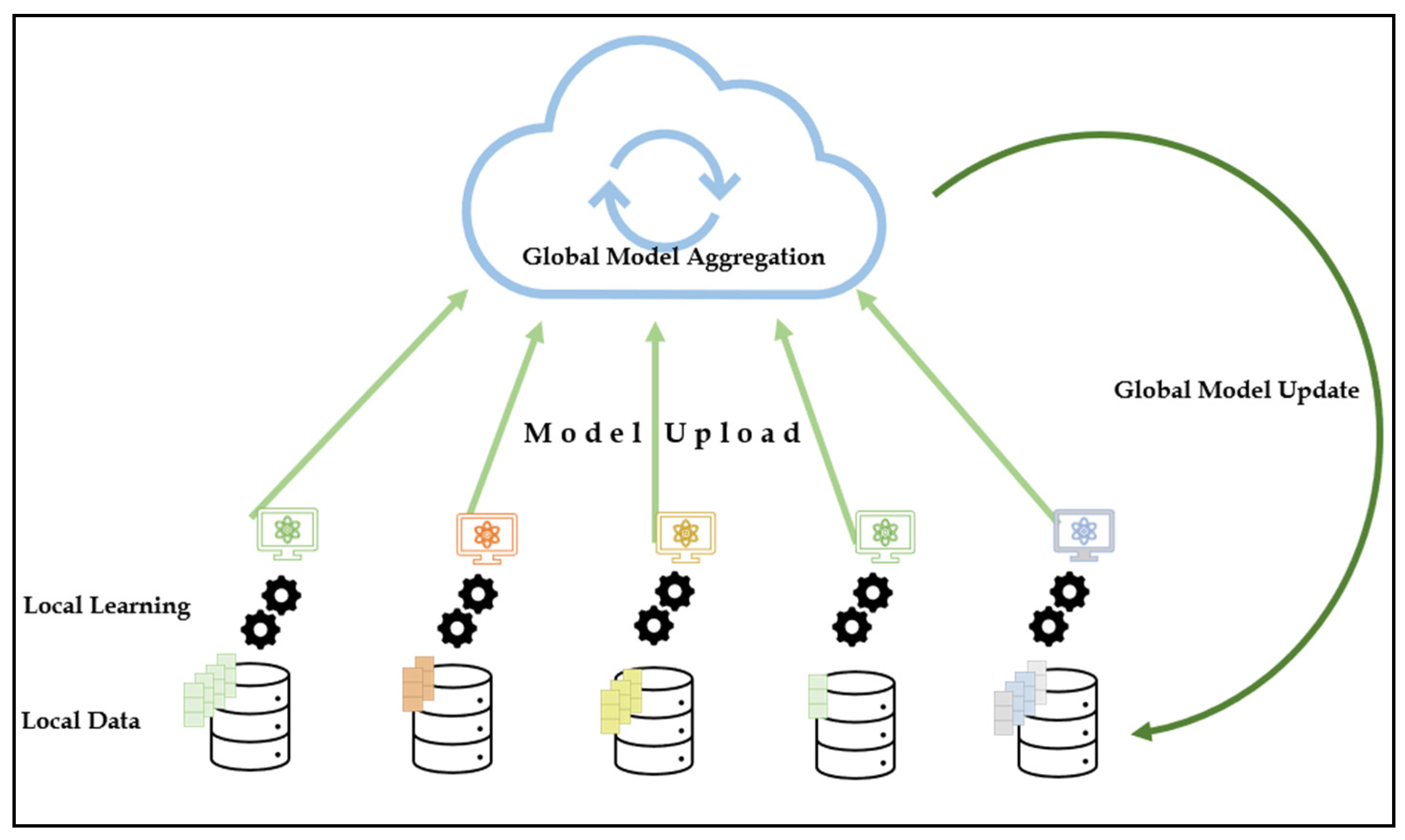
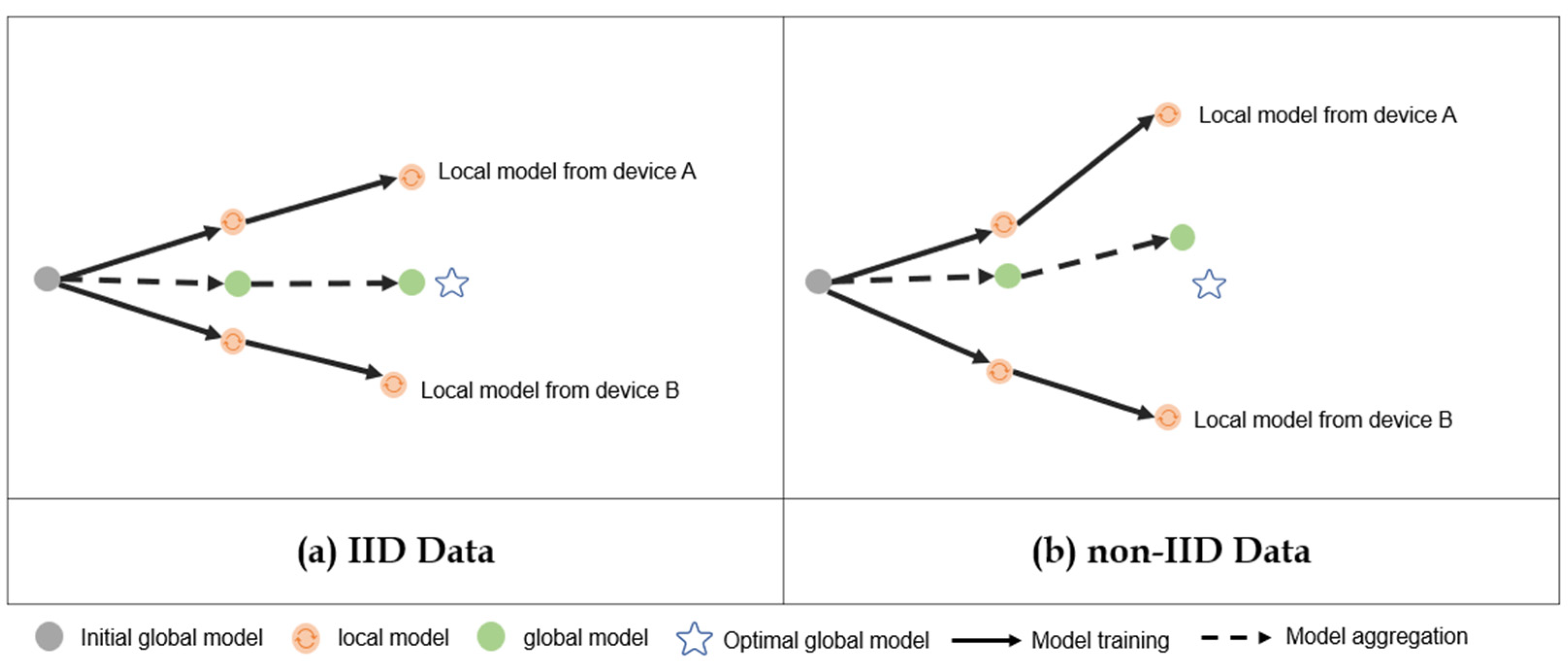


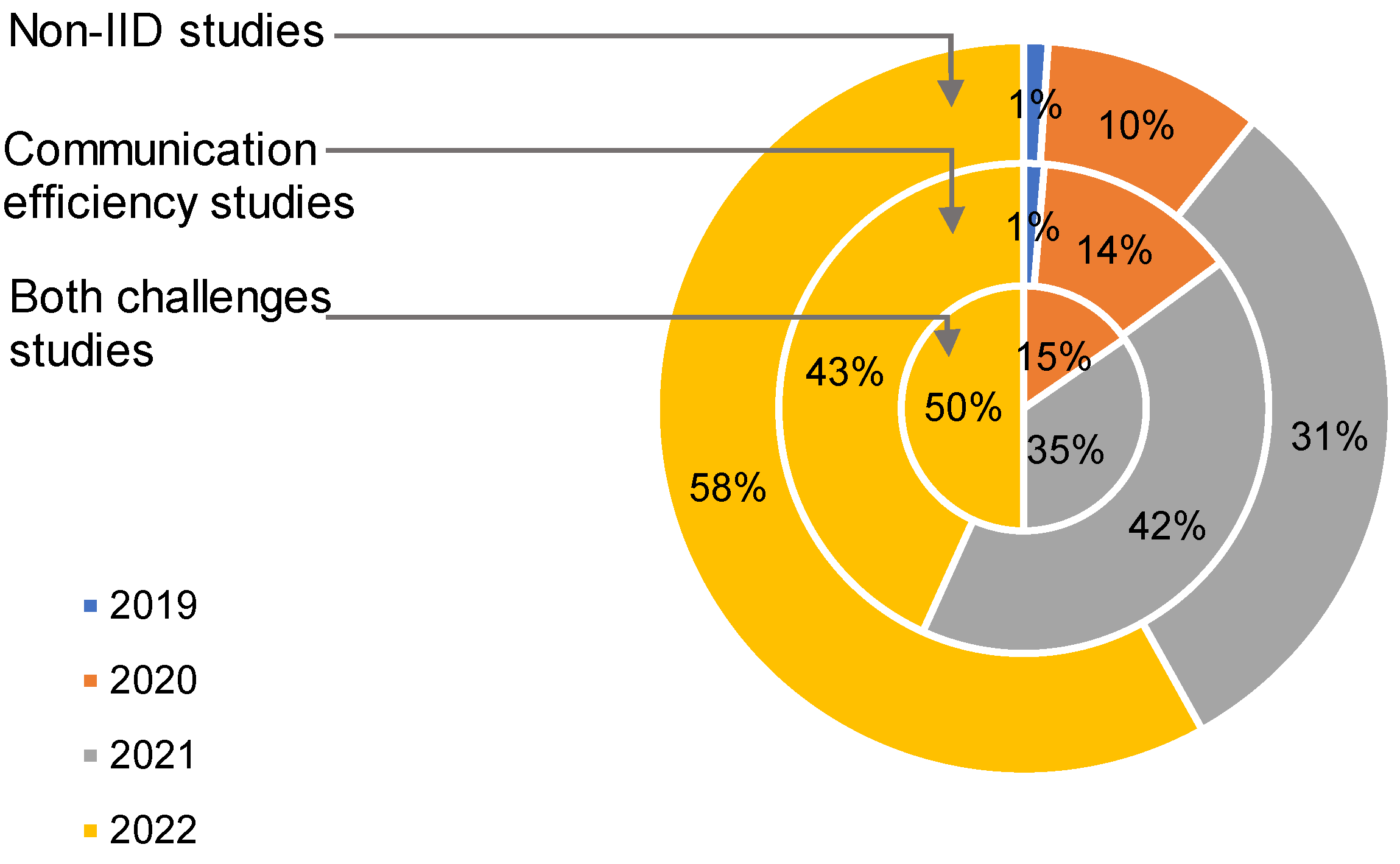
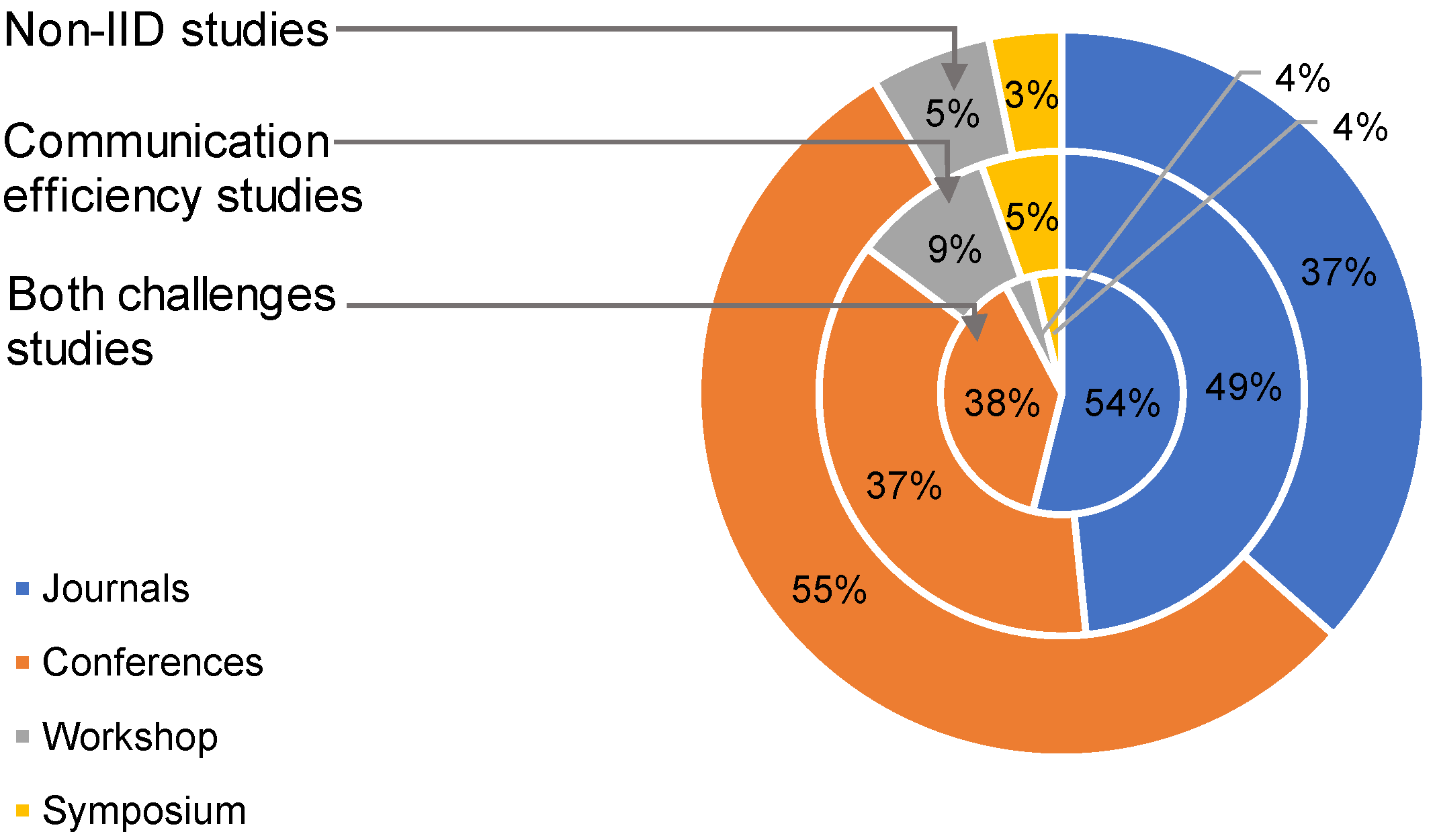
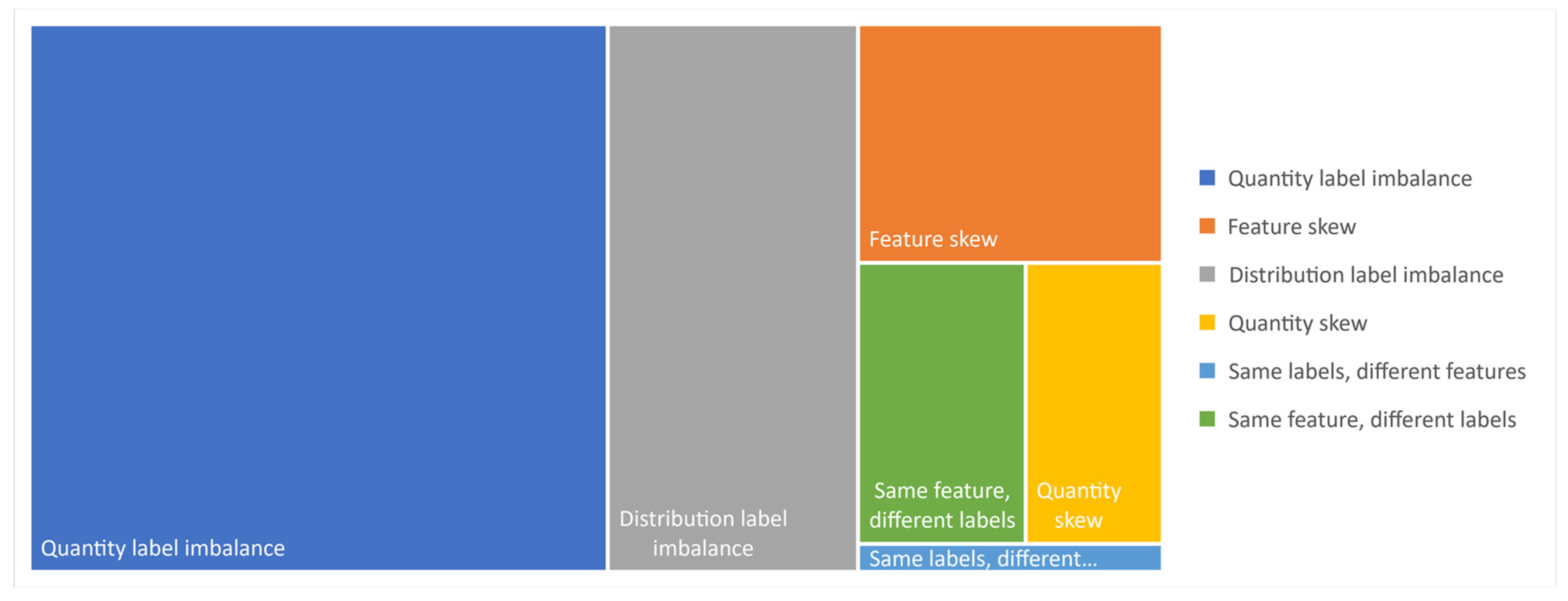
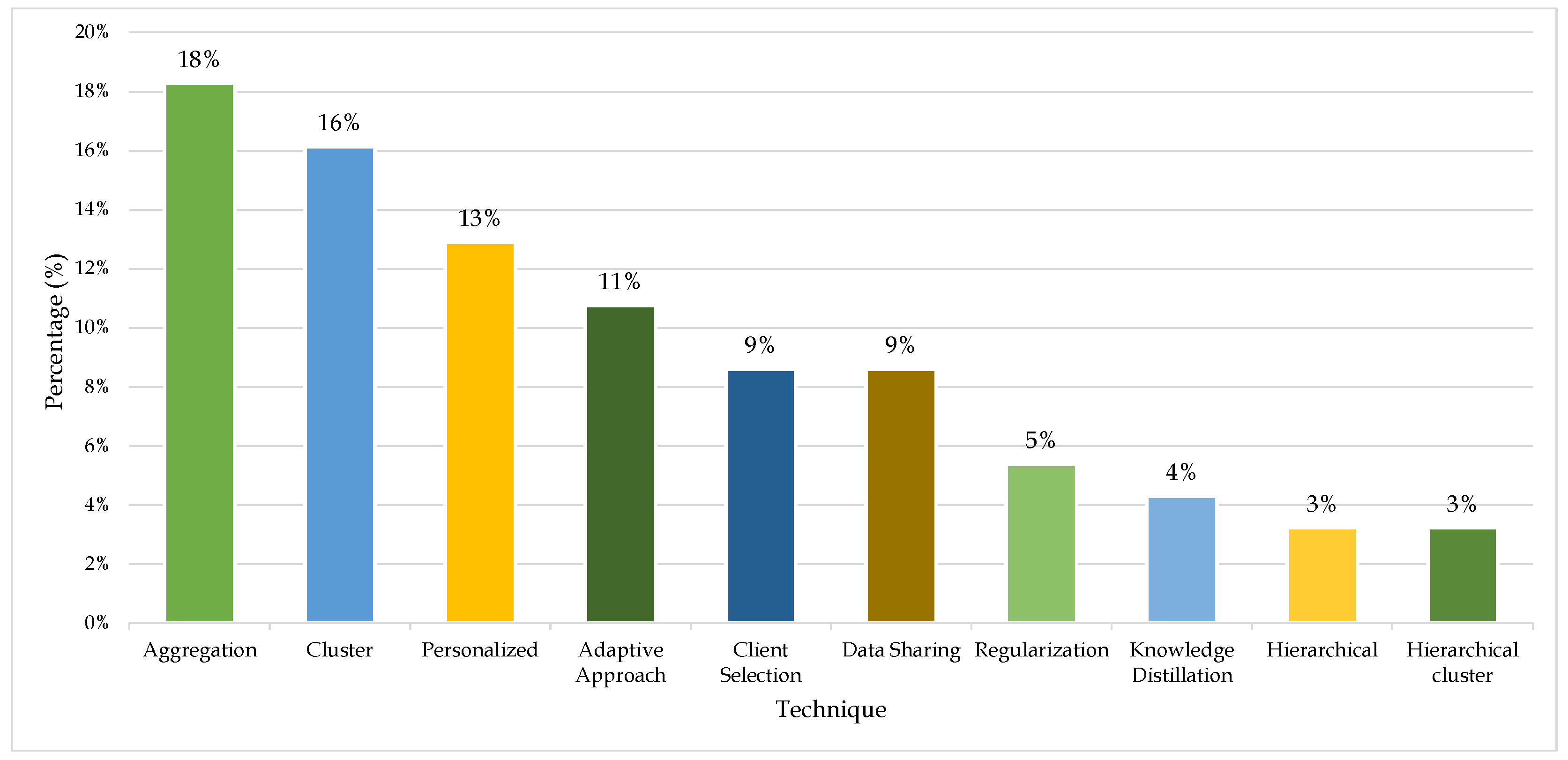

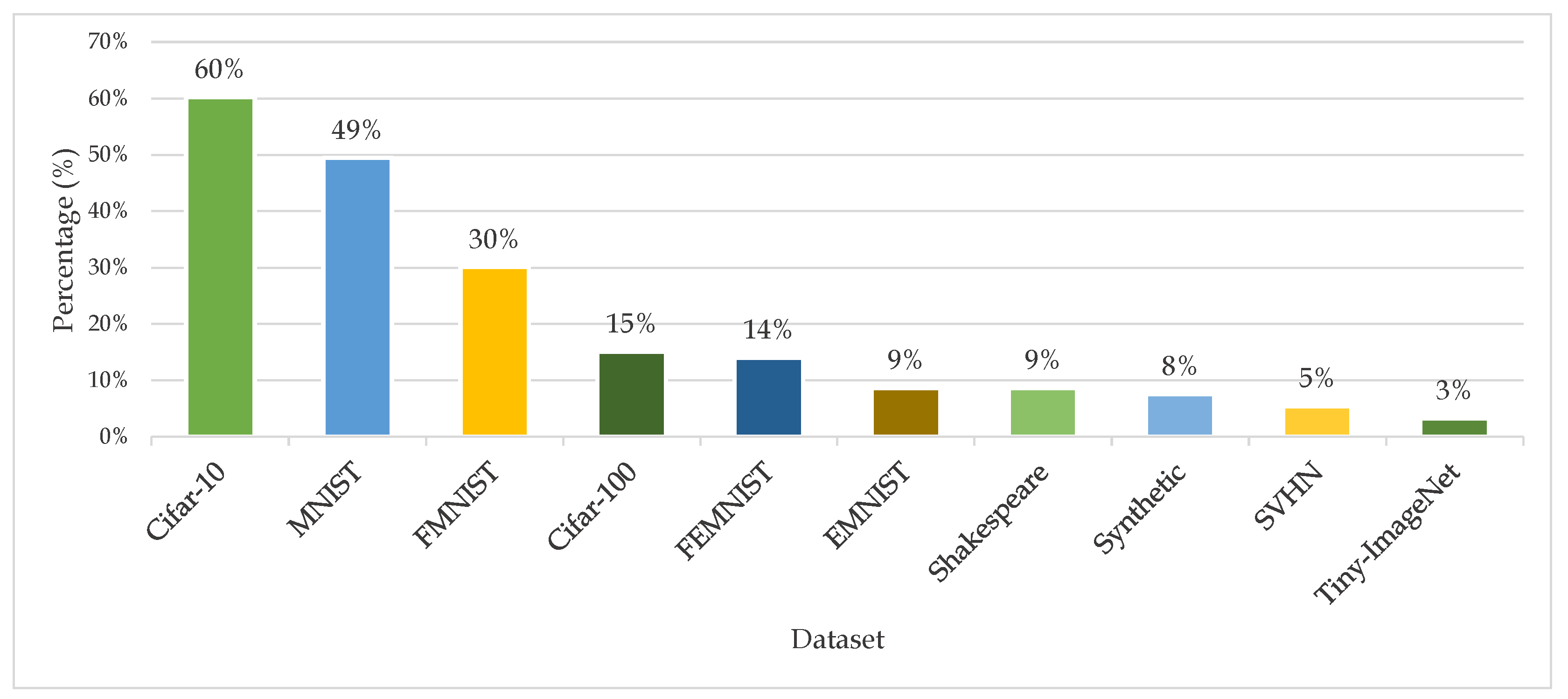

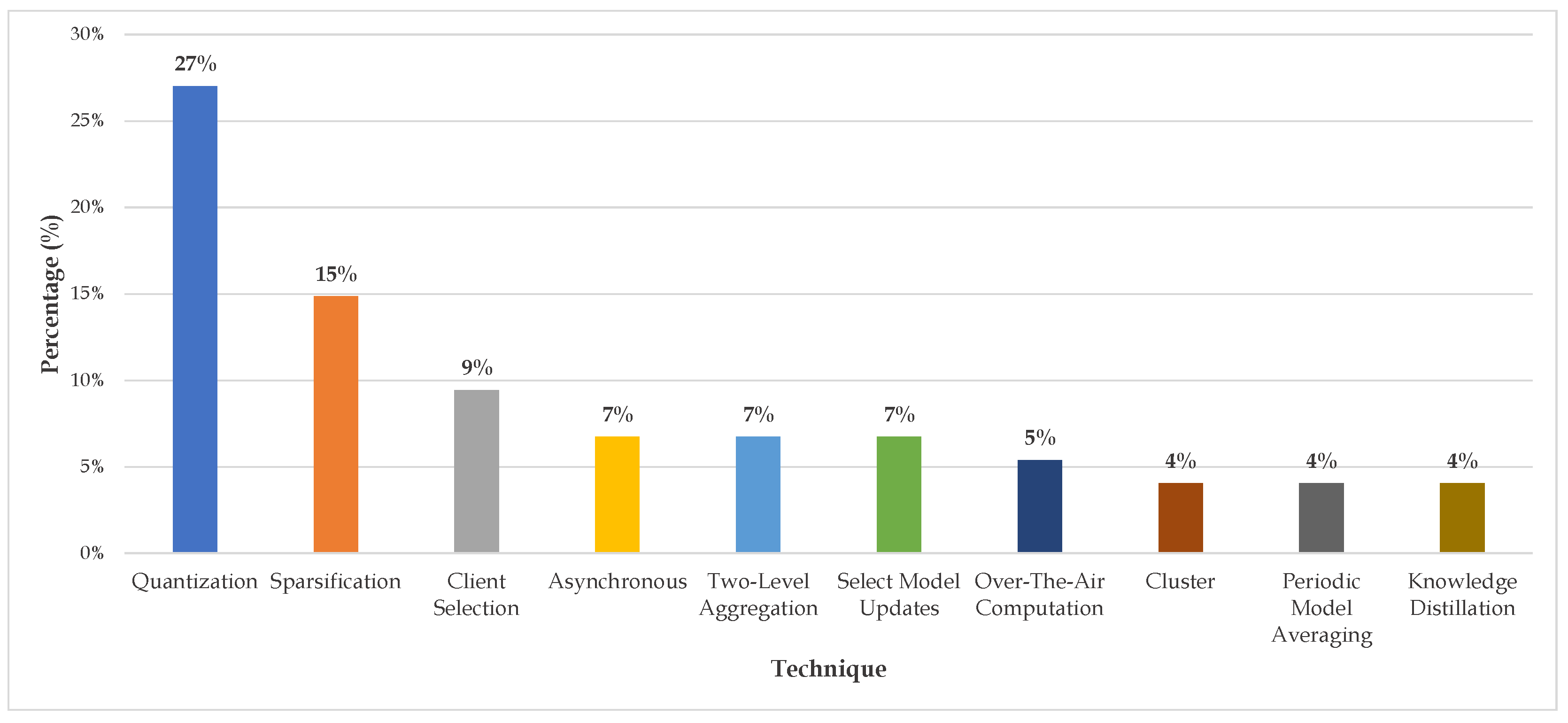
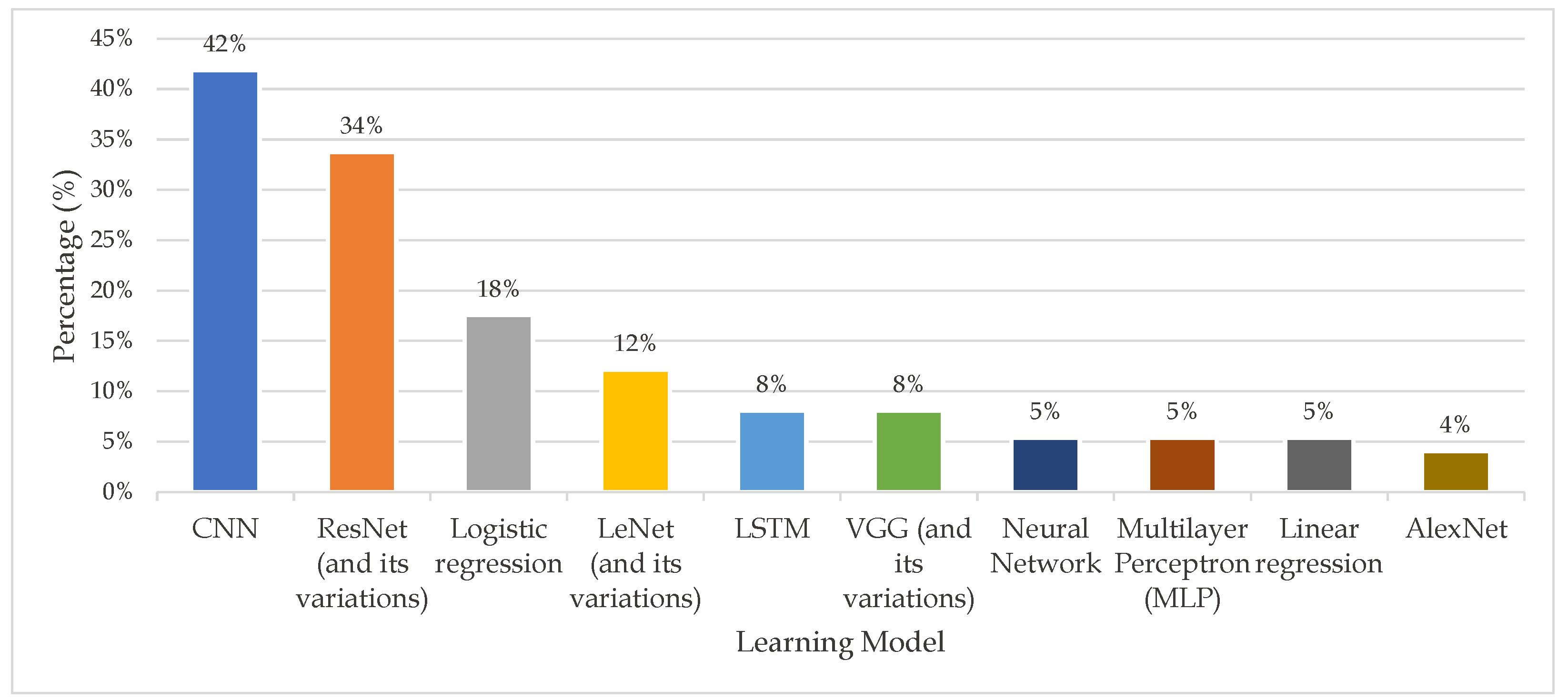
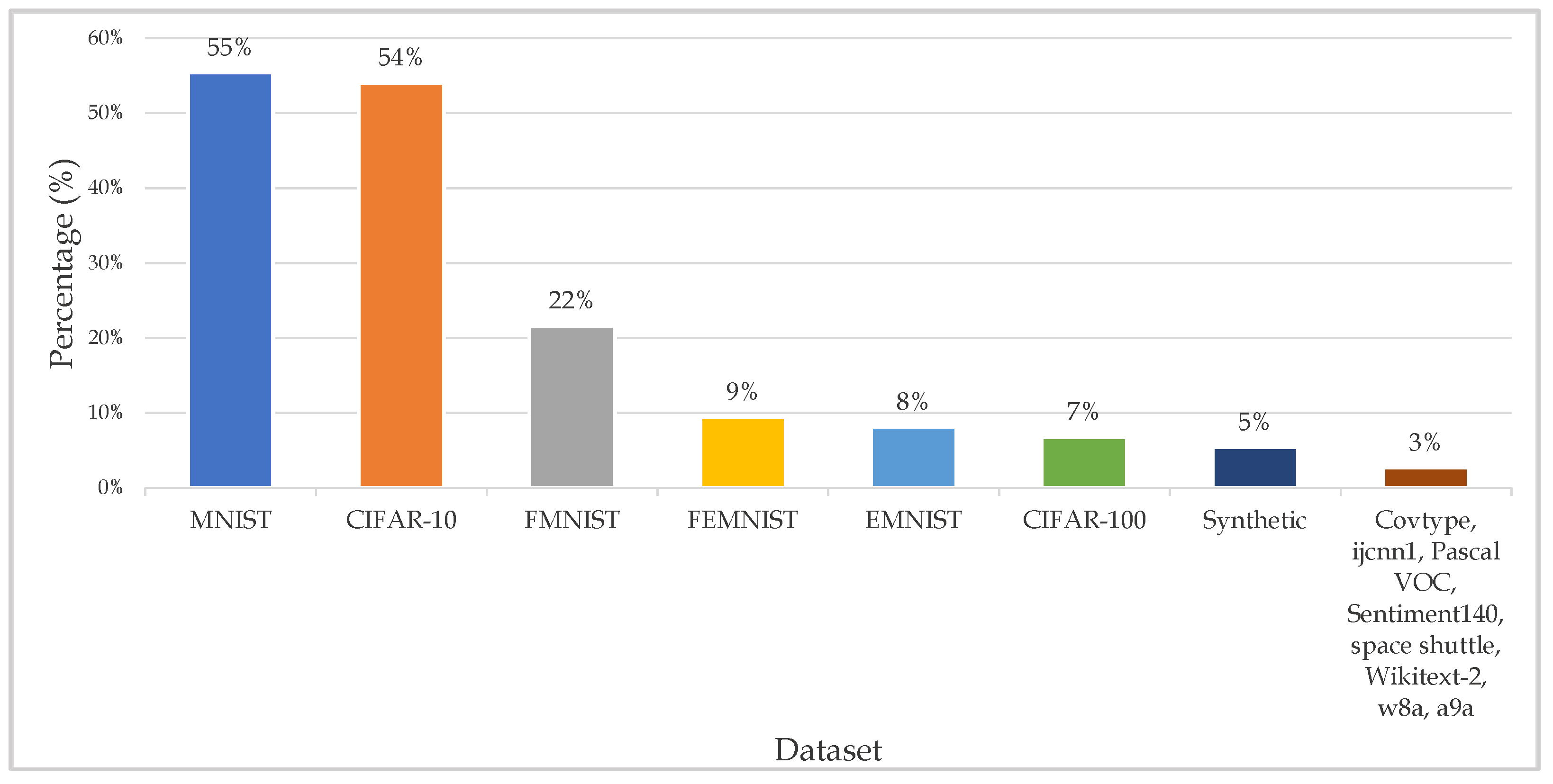

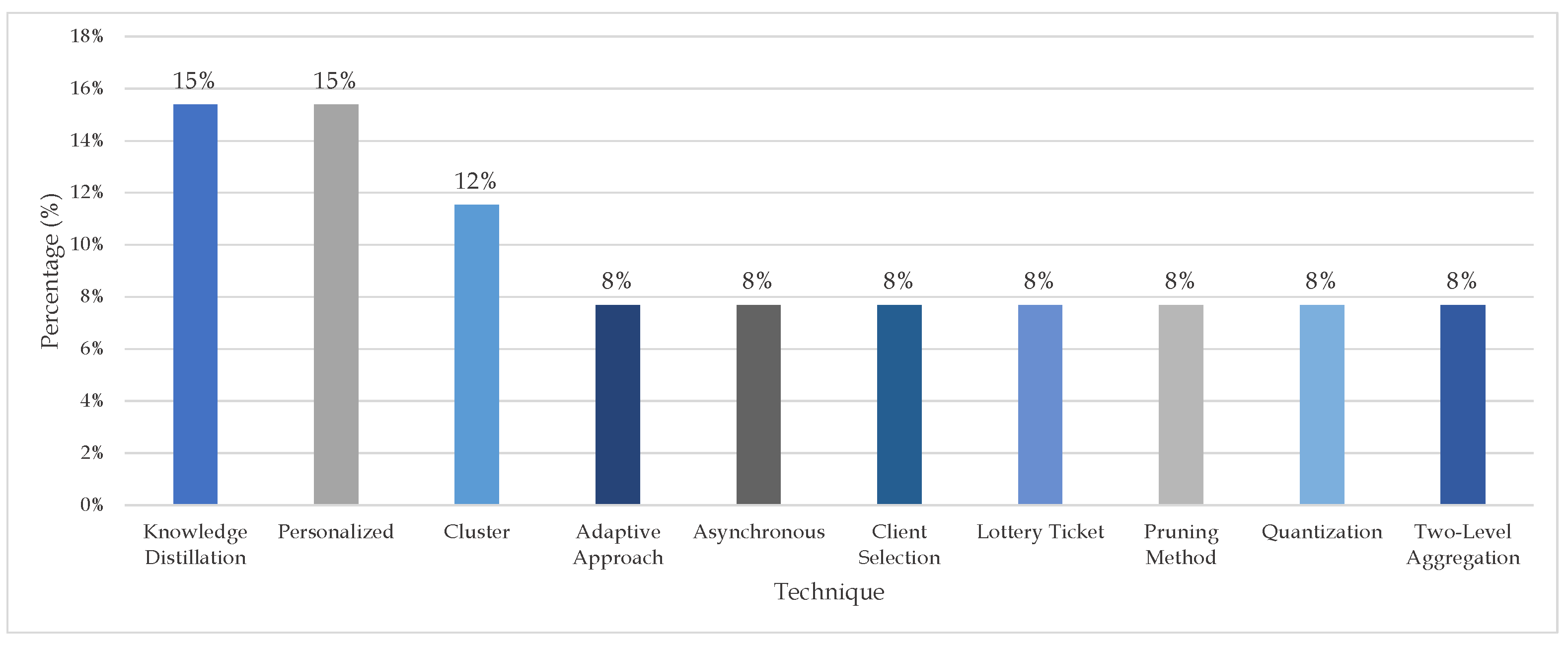
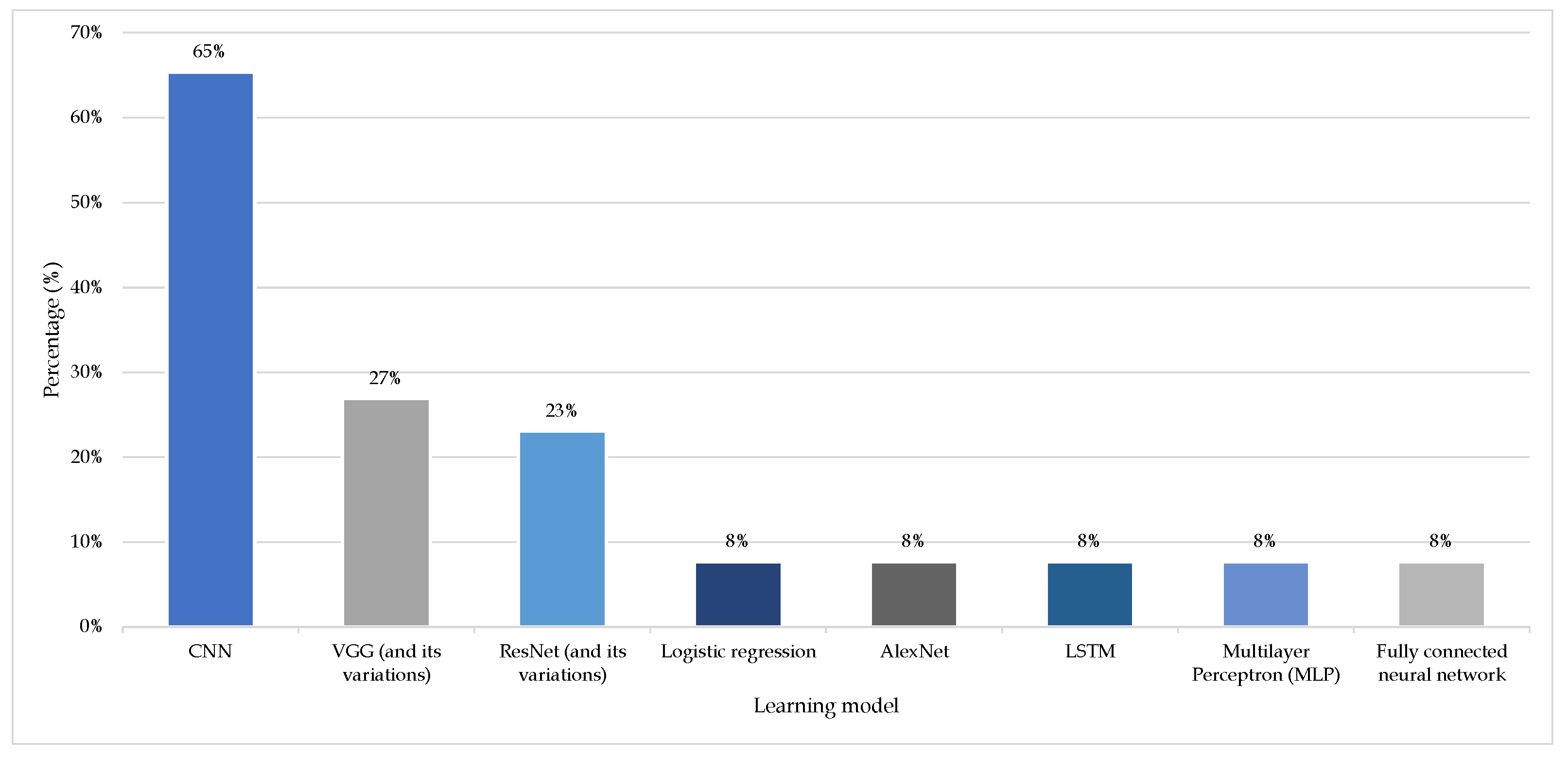
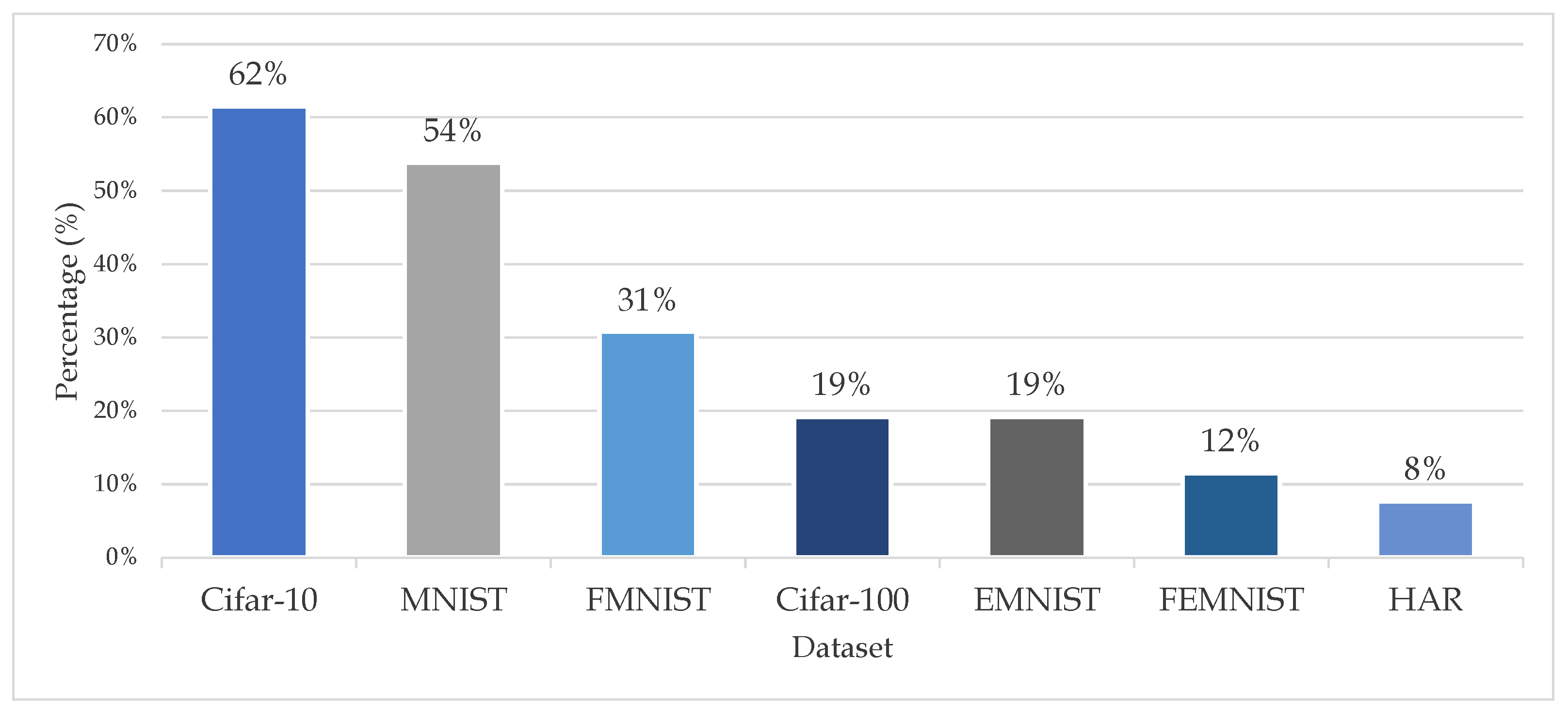

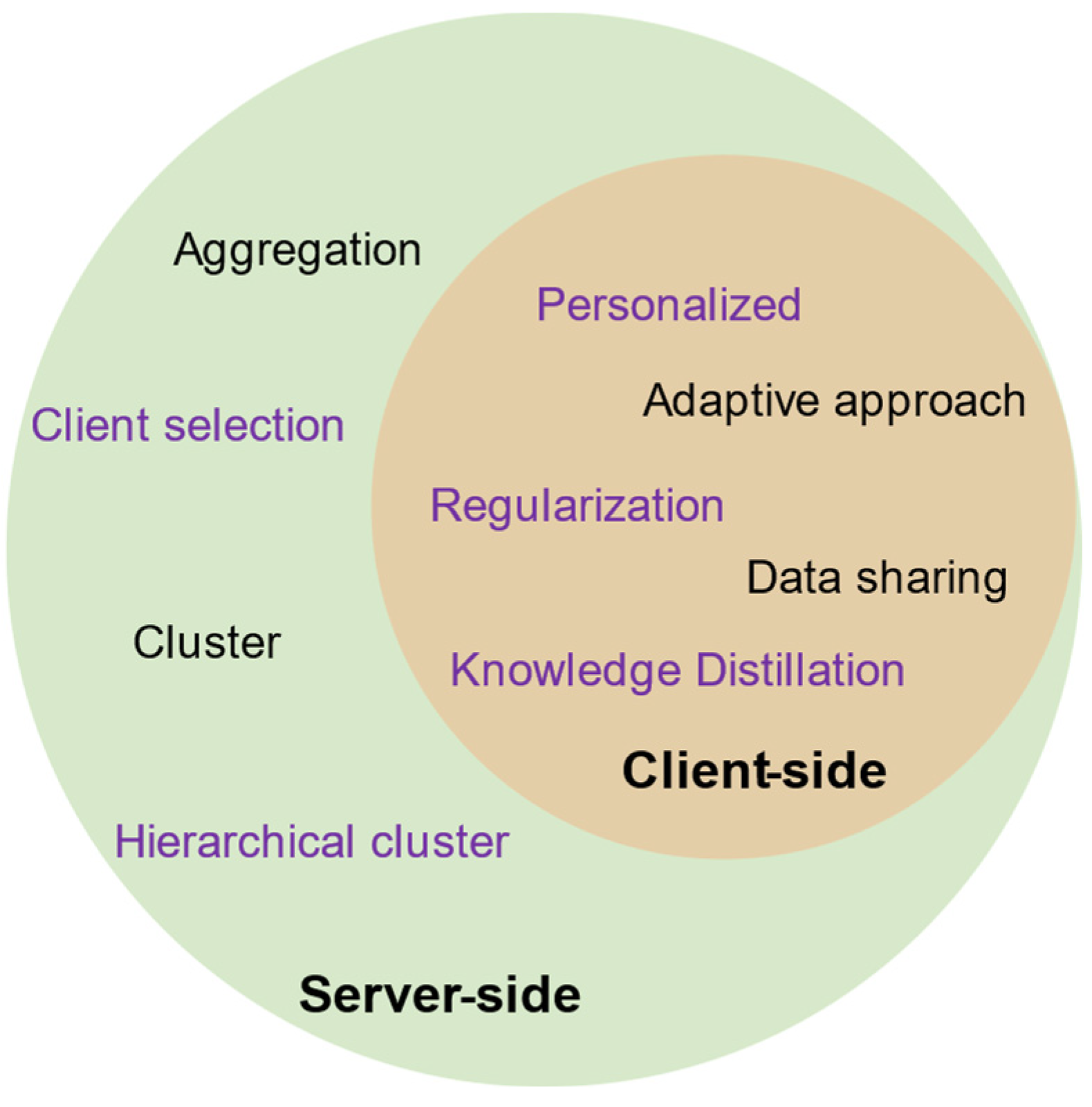

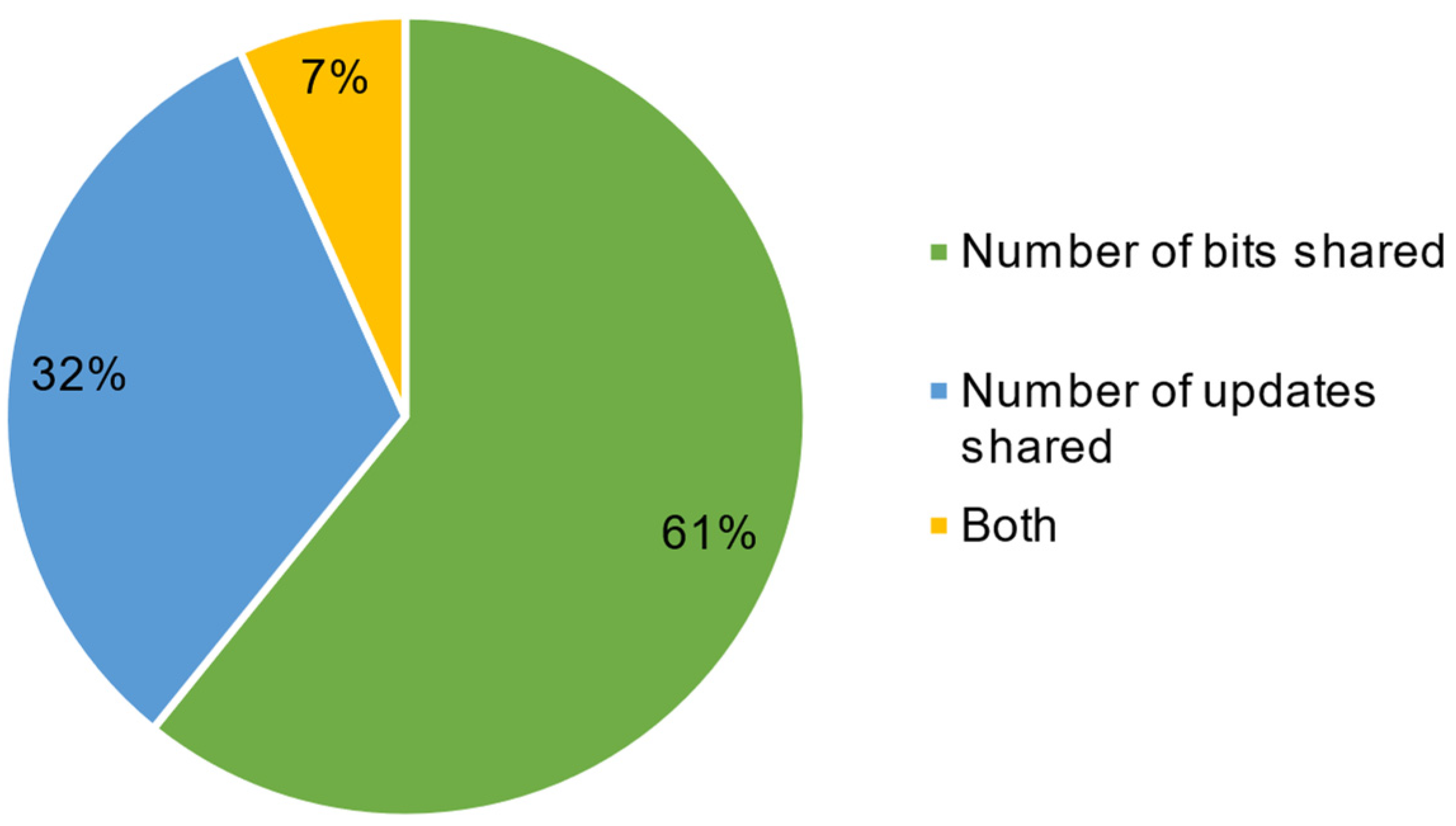
| Term | Alternative Synonyms |
|---|---|
| Federated learning | --- |
| non-IID data | non IID data, non-I.I.D data, not independent and identically distributed data |
| Communication-efficiency | Communication-efficient, Communication efficiency, Communication efficient |
| Database | Link |
|---|---|
| ACM Digital library | https://dl.acm.org/, accessed on 29 February 2024 |
| IEEE Xplore | https://ieeexplore.ieee.org, accessed on 29 February 2024 |
| Science Direct | https://www.sciencedirect.com/, accessed on 29 February 2024 |
| Springer Link | https://link.springer.com/, accessed on 29 February 2024 |
| John Wiley Online Library | https://onlinelibrary.wiley.com/, accessed on 29 February 2024 |
| Web of Science | https://www.webofscience.com/wos/woscc/basic-search, accessed on 29 February 2024 |
| Library | Number of Publications |
|---|---|
| ACM Digital library | 124 |
| IEEE Explore | 355 |
| Science Direct | 34 |
| Springer Link | 165 |
| John Wiley Online Library | 3 |
| Web of Science | 397 |
| Publication Venue | Type | No. | % |
|---|---|---|---|
| 2022 IEEE/CVF Conference on Computer Vision and Pattern Recognition (CVPR) | Conference | 3 | 3.23% |
| IEEE Transactions on Parallel and Distributed Systems | Journal | 3 | 3.23% |
| 2022 IEEE International Conference on Big Data (Big Data) | Conference | 2 | 2.15% |
| 2022 IEEE International Conference on Data Mining (ICDM) | Conference | 2 | 2.15% |
| ICC 2020—2020 IEEE International Conference on Communications (ICC) | Conference | 2 | 2.15% |
| 2021 International Joint Conference on Neural Networks (IJCNN) | Conference | 2 | 2.15% |
| 2021 IEEE 23rd Int Conf on High Performance Computing & Communications; 7th Int Conf on Data Science & Systems; 19th Int Conf on Smart City; 7th Int Conf on Dependability in Sensor, Cloud & Big Data Systems & Application (HPCC/DSS/SmartCity/DependSys) | Conference | 2 | 2.15% |
| KDD ’21: proceedings of the 27th ACM SIGKDD conference on knowledge discovery & data mining | Conference | 2 | 2.15% |
| Machine learning and knowledge discovery in databases | Conference | 2 | 2.15% |
| Computer Vision—ECCV 2022 | Conference | 2 | 2.15% |
| IEEE Transactions on Wireless Communications | Journal | 2 | 2.15% |
| IEEE Transactions on Network Science and Engineering | Journal | 2 | 2.15% |
| Future generation computer systems-the international journal of eScience | Journal | 2 | 2.15% |
| Publication Venue | Type | No. | % |
|---|---|---|---|
| IEEE Internet of Things Journal | Journal | 7 | 9.46% |
| IEEE Transactions on Wireless Communications | Journal | 3 | 4.05% |
| 2021 17th International Conference on Mobility, Sensing and Networking (MSN) | Conference | 2 | 2.70% |
| 2021 IEEE 41st International Conference on Distributed Computing Systems (ICDCS) | Conference | 2 | 2.70% |
| 2021 IEEE International Conference on Communications Workshops (ICC Workshops) | Conference | 2 | 2.70% |
| 2022 IEEE Globecom Workshops (GC Wkshps) | Workshop | 2 | 2.70% |
| GLOBECOM 2022—2022 IEEE Global Communications Conference | Conference | 2 | 2.70% |
| IEEE Transactions on Network Science and Engineering | Journal | 2 | 2.70% |
Disclaimer/Publisher’s Note: The statements, opinions and data contained in all publications are solely those of the individual author(s) and contributor(s) and not of MDPI and/or the editor(s). MDPI and/or the editor(s) disclaim responsibility for any injury to people or property resulting from any ideas, methods, instructions or products referred to in the content. |
© 2024 by the authors. Licensee MDPI, Basel, Switzerland. This article is an open access article distributed under the terms and conditions of the Creative Commons Attribution (CC BY) license (https://creativecommons.org/licenses/by/4.0/).
Share and Cite
Alotaibi, B.; Khan, F.A.; Mahmood, S. Communication Efficiency and Non-Independent and Identically Distributed Data Challenge in Federated Learning: A Systematic Mapping Study. Appl. Sci. 2024, 14, 2720. https://doi.org/10.3390/app14072720
Alotaibi B, Khan FA, Mahmood S. Communication Efficiency and Non-Independent and Identically Distributed Data Challenge in Federated Learning: A Systematic Mapping Study. Applied Sciences. 2024; 14(7):2720. https://doi.org/10.3390/app14072720
Chicago/Turabian StyleAlotaibi, Basmah, Fakhri Alam Khan, and Sajjad Mahmood. 2024. "Communication Efficiency and Non-Independent and Identically Distributed Data Challenge in Federated Learning: A Systematic Mapping Study" Applied Sciences 14, no. 7: 2720. https://doi.org/10.3390/app14072720
APA StyleAlotaibi, B., Khan, F. A., & Mahmood, S. (2024). Communication Efficiency and Non-Independent and Identically Distributed Data Challenge in Federated Learning: A Systematic Mapping Study. Applied Sciences, 14(7), 2720. https://doi.org/10.3390/app14072720





